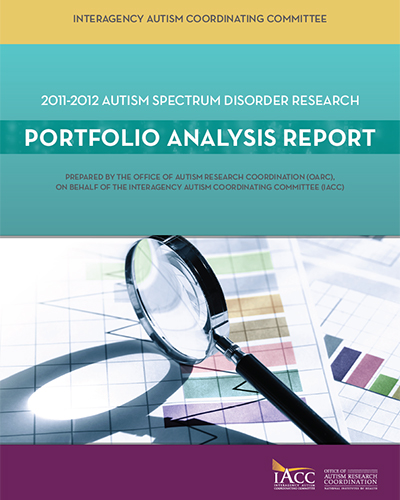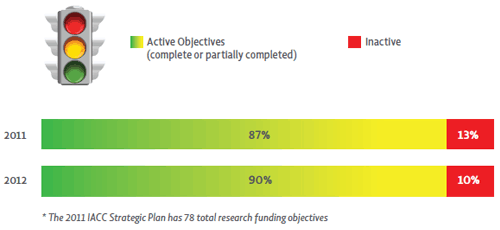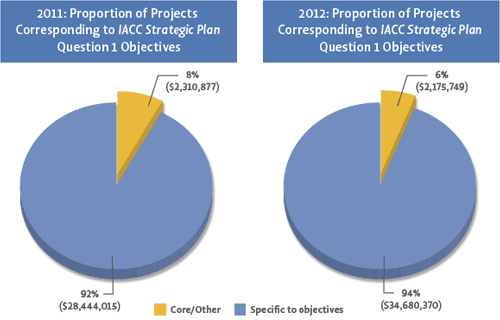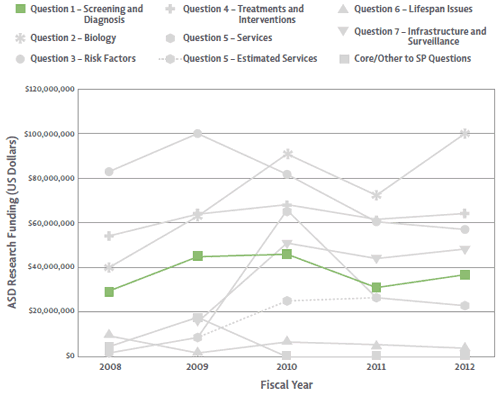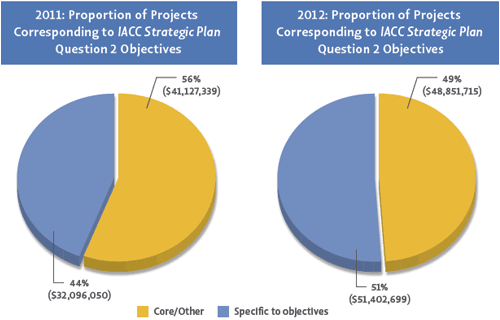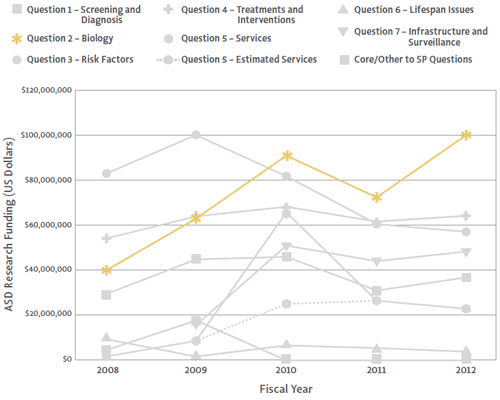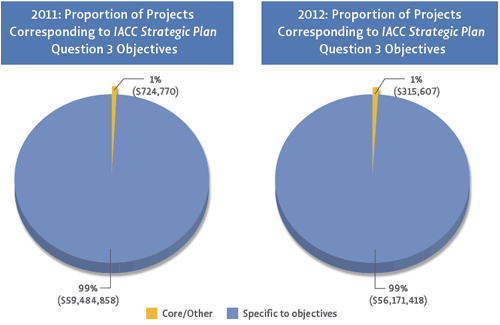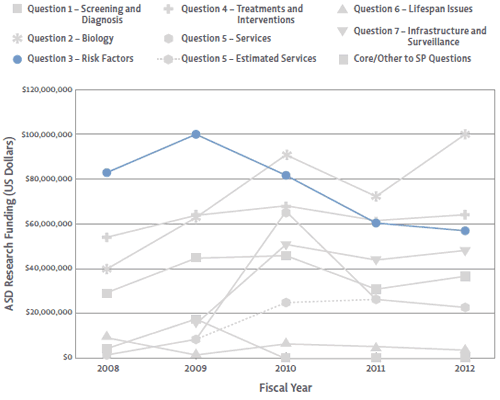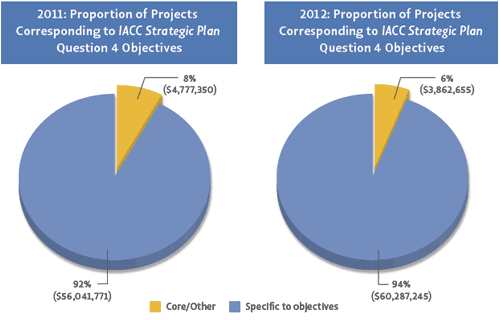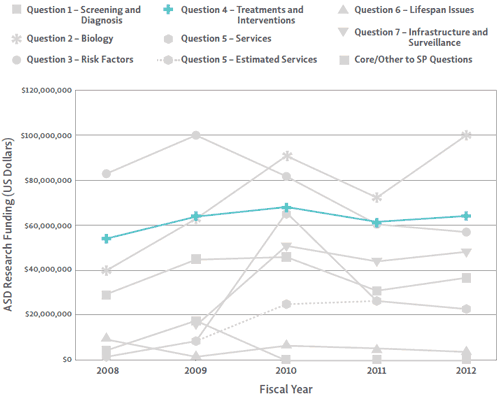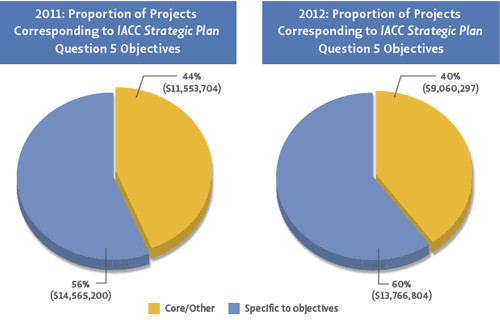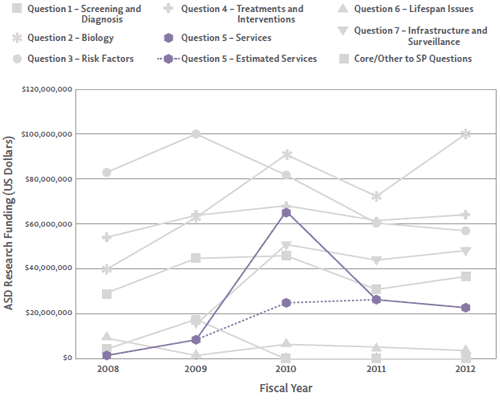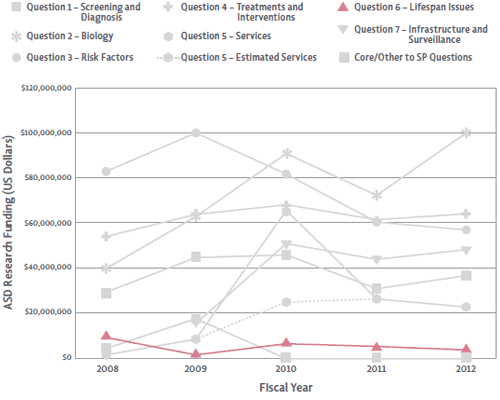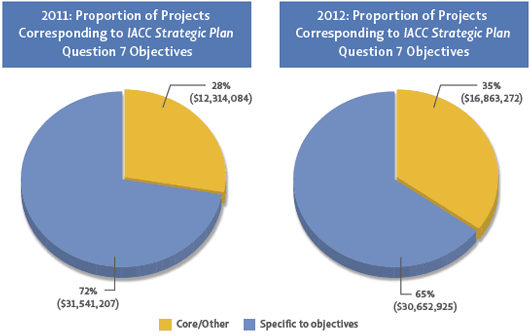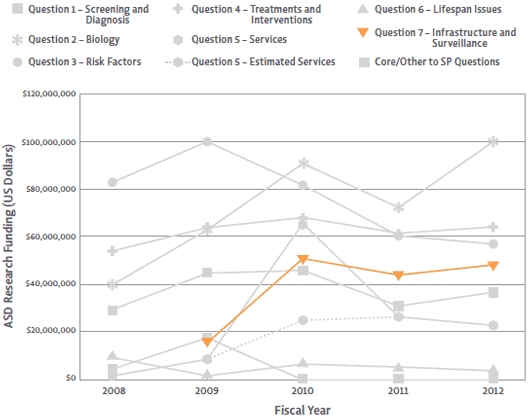Portfolio Analysis Report
IACC Autism Spectrum Disorder Research
2011 - 2012
The 78 objectives in the Strategic Plan describe specific research priorities identified by the IACC, each with a goal date for initiation and a professional judgment estimate of the budget that may be required to accomplish the objective.1 Each ASD project that received funding in 2011 and 2012 was evaluated with respect to the 78 objectives in the 2011 IACC Strategic Plan for ASD Research2 in order to determine which Strategic Plan question and objective it fulfilled. Analysis of the full portfolio of government and privately funded projects aligned with the IACC Strategic Plan objectives yielded information about the progress that has been made toward completion of the objectives in the 2011 Strategic Plan. In 2011, this analysis indicated that of the 78 objectives in the IACC Strategic Plan, 87% (68 objectives) were underway or completed, and in 2012, 90% (70 objectives) were underway or completed (green or yellow in the stoplight figure as explained below) (See Figure 17). Further discussion of the progress toward achievement of individual Strategic Plan objectives is found in subsequent chapters of this report. The analysis also enabled assessment of areas of research where more work may be needed to achieve Strategic Plan objectives.
1Professional judgment budget estimates for each of the IACC Strategic Plan objectives were formulated by scientific and program experts in the field and provide an estimate of what it may cost to conduct each of the projects described. The IACC provided these budget recommendations as guidance to Federal agencies and partner organizations on the potential cost of conducting the recommended research. The IACC’s role in research is advisory, and the Committee does not have its own research budget to conduct or support research.
2The 2011 IACC Strategic Plan is the most recent update of the Strategic Plan where new objectives were added. The subsequent 2012 and 2013 updates of the Strategic Plan did not include any edits to the objectives, therefore the objectives as described in the 2011 IACC Strategic Plan were used to code the 2011 and 2012 projects to specific objectives.
Figure 17. This figure provides the percentage of the total number of IACC Strategic Plan objectives that have been completed to date, based on an analysis of funded projects assigned to each of the Strategic Plan’s 78 objectives. As of 2012, 90% of objectives were either complete or partially complete (had all or some of the required funded projects), with 10% of objectives having no activity/assigned projects.
Upcoming chapters in this report give an overview of the progress on completing objectives in each question of the Strategic Plan in 2011 and 2012. The overall progress for each question is denoted by a stoplight figure for each year at the beginning of each chapter. Within each stoplight figure, the number in the green light indicates the number of objectives that have been considered completed, the number in the yellow light indicates the number of objectives partially completed, and the number of objectives in the red light indicates the number of objectives where no progress has been documented through the portfolio analysis. Each of the chapters describing the progress in the seven Strategic Plan question areas also contains a table that provides information about the progress made toward completion of the Strategic Plan objectives over a five-year period from 2008 through 2012.
Question 1: Screening and Diagnosis
Aspirational Goal: Children at risk for ASD will be identified through reliable methods before ASD behavioral characteristics fully manifest
Research Focus of Question 1
Question 1 of the IACC Strategic Plan ("When should I be concerned?") pertains to the issues surrounding screening for and diagnosis of ASD, with a focus on early identification of children showing signs of ASD so that they have the opportunity to receive interventions and supports that will lead to improved outcomes. The objectives within this chapter of the Strategic Plan include research to develop biomarkers, screening tools, and diagnostic instruments to aid in early identification. Question 1 also includes research to better understand and overcome barriers to early identification, including efforts to increase access to health services, and to develop or adapt screening and diagnostic tools for use in a wide variety of community settings, at low cost, and in diverse populations. The Committee also prioritized the need for screening and diagnostic tools for use in adolescents and adults and for improved measures that can be used to assess intervention and service needs. Projects addressing issues related to adult screening and diagnosis may be captured either within Question 1 or Question 6 of the Strategic Plan (Question 6 focuses on issues relevant to transitioning youth and adults on the autism spectrum).
Analysis of Question 1 Portfolio 2011-2012
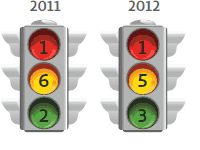 When analyzing the distribution of research dollars across the seven question areas described in the IACC Strategic Plan, projects assigned to Question 1 of the Strategic Plan comprised 10% ($30.8 million) of the total ASD research supported by Federal and private funders in 2011, and 11% ($36.9 million) of total funding for ASD research in 2012. The number of projects assigned to Question 1 totaled 137 (11% of all projects) in 2011, and 135 (10% of all projects) in 2012. A list of the agencies funding research pertaining to Question 1 can be found in Figures 19 and 20. The largest funders of research pertaining to Question 1 (Screening and Diagnosis) are the National Institutes of Health ($25.2 million), the Simons Foundation ($4.2 million), and the National Science Foundation ($4.1 million).
When analyzing the distribution of research dollars across the seven question areas described in the IACC Strategic Plan, projects assigned to Question 1 of the Strategic Plan comprised 10% ($30.8 million) of the total ASD research supported by Federal and private funders in 2011, and 11% ($36.9 million) of total funding for ASD research in 2012. The number of projects assigned to Question 1 totaled 137 (11% of all projects) in 2011, and 135 (10% of all projects) in 2012. A list of the agencies funding research pertaining to Question 1 can be found in Figures 19 and 20. The largest funders of research pertaining to Question 1 (Screening and Diagnosis) are the National Institutes of Health ($25.2 million), the Simons Foundation ($4.2 million), and the National Science Foundation ($4.1 million).
Progress made in 2011 and 2012 toward completion of the nine objectives in Question 1 is indicated by the two stoplight icons at the beginning of this chapter and is described in detail in the table at the end of this chapter (Table 5). To summarize progress, in 2011, two Question 1 objectives were considered completed in terms of the number and types of projects funded and the amount of funding invested. Partial progress was made on six objectives, while no progress was documented through the portfolio analysis data collection toward one objective. In 2012, one additional objective moved from the “partially completed” to the “completed” category, bringing that number to three, with partial progress on five objectives, and no documented progress on one objective.
The Question 1 objective receiving the most funding (1.L.A) in 2011 and 2012 focuses on research geared toward discovering biomarkers for ASD; it received 41% ($12.4 million) and 35% ($12.9 million) of the Question 1 funding in 2011 and 2012 respectively. This was followed by Objective 1.L.B, which supports studies investigating the use of biological signatures for diagnosis, risk assessment, and intervention for ASD, which accounted for 31% ($9.4 million) of Question 1 overall funding in 2011 and 34% ($12.8 million) in 2012. All other objectives received less than 10% of Question 1 funding in both 2011 and 2012. In 2011, 8% ($2.3 million) of funding for Question 1 went to projects categorized as Core/Other, or not specific to Question 1 objectives (Figure 18). In 2012, 6% ($2.2 million) of funding for Question 1 went to Core/Other projects (Figure 18). Table 5 lists all the objectives and key details of their progress to date.
As in 2010, Objective 1.S.D, which calls for studies to understand the impact of early diagnosis on choice of intervention and outcomes, did not have any projects assigned to it in 2011 and 2012 (Table 5). As described in the IACC Strategic Plan 2013 Update and Table 5, when examining reasons why this objective has no assigned projects, the Committee felt that the lack of progress may be due to unclear wording of the objective, partial overlap with other objectives, and advances in research that have made some aspects of the objective less relevant. At the time the objective was written, early intervention was not in widespread use, so part of the original intent of the objective may have been to determine whether early diagnosis influences families to choose early interventions. Since 2008, the evidence base for early intervention has strengthened, and early interventions are now widely used following early diagnosis, so the question of whether families would choose early intervention may not be as relevant as it may have been previously. Due to all of the issues mentioned above, the Committee decided to revisit this objective in the future for possible revision or elimination.
For Objective 1.S.C, in 2010 there were no studies aimed at identifying reasons for health disparities in accessing early screening and diagnosis services, but in 2011 and 2012 new research projects were funded in this area, moving this objective from a red light to a yellow light status. With regard to Objective 1.S.F, NIH held a workshop in 2011 to address the ethical, legal, and social issues and implications (ELSI) of ASD research, and the Autistic Self Advocacy Network and Autism Speaks each also held workshops addressing this topic. Thus, Objective 1.S.F was completed, moving it from a red light to a green light status.
Examples of Topics addressed by Projects in Core/Other:
- Research on early signs of autism, including sensory, motor, social, and linguistic development
- Development of technologies that can be applied to screening and diagnosis of ASD
- Evaluation of how changes in diagnostic criteria may impact community practice and ASD surveillance activities
Figure 18. Most ASD research projects in Question 1 were coded to specific objectives; projects on topics not covered by the IACC Strategic Plan objectives were coded as Core/Other. Examples of the topics addressed by projects in Core/Other are listed above.
Question 1 Subcategory Analysis
With the development of the subcategory categorization scheme for the IACC ASD Research Portfolio Analysis Report, all projects can be categorized into broad research-related topic areas or themes, including projects that did not fit within the specific research objectives laid out in the Strategic Plan. This enables a more comprehensive understanding of the distribution of all projects across the general research areas aligning with Question 1. Overall, projects in Question 1 neared $31 million in 2011 and $37 million in 2012 and were divided into four subcategories:
Diagnostic and screening tools; Early signs and biomarkers; Intermediate phenotypes/Subgroups; and Symptomology (Figures 19 and 20). There were 137 (in 2011) and 135 (in 2012) projects that fell within Question 1. Of these, the largest portion of funding (56% in 2011 and 43% in 2012) was focused on research to identify Early signs and biomarkers of ASD (especially those that can be used for screening/diagnosis or to measure progress or treatment response). Both biological indicators (including genetic, metabolic, and brain structure/connectivity) and behavioral biomarkers were included in this subcategory. Studies in this subcategory included eye-tracking, measures of infant and toddler development (often comparing children with ASD to their unaffected siblings or to typically developing children), and methods for identifying social or behavioral differences. Research evaluating and defining the Symptomology of ASD was the second largest research investment in Question 1 (18% in 2011 and 27% in 2012). Research in this category included projects that investigate differences in development of social communication and language in those with ASD, and how neurocognitive impairments might contribute to core ASD symptoms. The development of Diagnostic and screening tools accounted for 14% and 18% of Question 1 funding in 2011 and 2012 respectively. The smallest Question 1 subcategory includes research on ASD Intermediate phenotypes/Subgroups (11% in 2011 and 11% in 2012). Only one project assigned to Question 1 did not align well with the subcategories (funding for the ELSI workshop in 2011) and is therefore represented as “Other” in Figure 19. The figure also lists Federal and private funders of research that fits within the Strategic Plan Question 1 category.
2011 Question 1: Screening and Diagnosis – Funding by Subcategories
Total Funding: $30,754,892
Number of Projects: 137
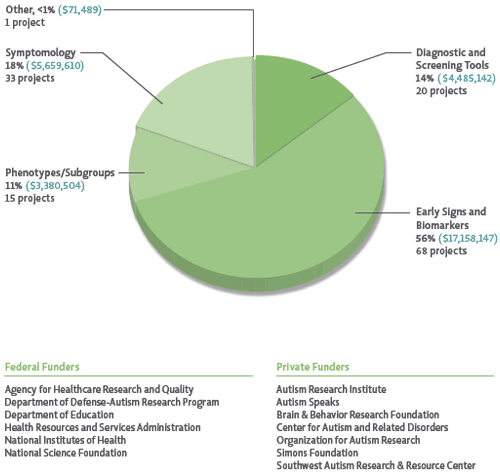
Figure 19. Of the four subcategories related to Question 1 (Screening and Diagnosis), in 2011 the largest proportion of funding was devoted to identifying Early signs and biomarkers for ASD (56%). This was followed by characterizing Symptomology (18%), developing Diagnostic and screening tools (14%), and identifying/characterizing Intermediate phenotypes/Subgroups of people with ASD (11%). Lastly, in the subcategory analysis, a workshop focused on the ethics of autism research was categorized as Other (<1%) because it does not fall under one of the four Question 1 subcategories. Federal and private funders of research fitting within Strategic Plan Question 1 are indicated at the bottom of the figure.
2012 Question 1: Screening and Diagnosis – Funding by Subcategories
Total Funding: $36,856,119
Number of Projects: 135
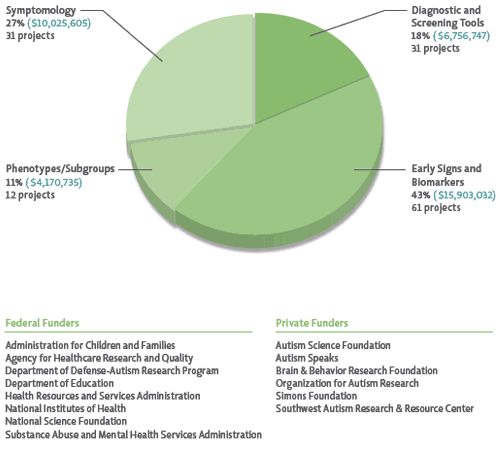
Figure 20. In 2012, funding across the four subcategories for research related to Question 1 (Screening and Diagnosis) was distributed similarly to 2011. Identifying Early signs and biomarkers for ASD represented the largest portion of funding in this question (43%), followed by characterizing Symptomology (27%), developing Diagnostic and screening tools (18%), and finally identifying Intermediate phenotypes/Subgroups of people with ASD (11%). Federal and private funders of research fitting within Strategic Plan Question 1 are indicated at the bottom of the figure.
Progress Made on Question 1 from 2008-2012
Table 5 provides a snapshot of progress made on all nine of the research objectives within Question 1 over the five-year period from 2008-2012, with green, yellow, and red highlighting to indicate the level of budgetary progress of each objective in each year. The table also provides details regarding the status of funding for projects that address each objective, the status of research/scientific progress in each objective area, and information about remaining gaps, needs, and opportunities in each research area. Figure 21 shows the trend in Question 1 funding over time. Funding for Question 1 peaked in 2009 and 2010, coincident with the increase in federal funding for autism research that year due to the American Recovery and Reinvestment Act (ARRA). Question 1 funding in 2012 was slightly below the level reported in 2008. Overall, aside from the slight rise in 2009 and 2010, the funding level was moderate and stayed relatively flat during the five-year period.
Overall, progress has been made in funding projects to address the research needs described in eight of the nine Question 1 objectives (Table 5 – progress level indicated in the “Total” column with yellow or green highlighting). No projects were reported from 2008-2012 for Objective 1.S.D, “Conduct at least two studies to understand the impact of early diagnosis on choice of intervention and outcomes by 2015.” While there may be projects that were coded to Question 4 that may partially address Objective 1.S.D., as mentioned previously, the Committee felt overall that the objective was unclear in its wording, less relevant based on the current state of the science than at the time of its establishment in 2008, and potentially warranted revision or elimination in future iterations of the Strategic Plan.
Figure 21. Question 1 ASD Research Funding from 2008-2012. Funding for Question 1 was moderate and stayed relatively flat over the five-year span.
Question 1 Multiyear Funding Table
| IACC Strategic Plan Objectives | Funding | |||||
|---|---|---|---|---|---|---|
| Year | 2008 | 2009 | 2010 | 2011 | 2012 | Total |
IACC Strategic Plan ObjectivesDevelop, with existing tools, at least one efficient diagnostic instrument (i.e., briefer, less time intensive) that is valid in diverse populations for use in large-scale studies by 2011. IACC Recommended Budget: $5,300,000 over 2 years |
Funding 20081.1 |
Funding 20091.S.A |
Funding 20101.S.A |
Funding 20111.S.A |
Funding 20121.S.A |
Funding Total$14,368,811 |
1.S.A. Funding: The recommended budget was met. Significantly more than the recommended minimum budget was allocated to projects specific to this objective Progress: Though several projects are underway to develop efficient screeners and diagnostic tools, the overarching aim of this objective has not yet been achieved. Remaining Gaps, Needs, and Opportunities: In addition to efficiency, emphasis should be placed on developing cost-effective, performance-based tools, and on validating these across diverse populations. Recent RFAs issued by NIMH and Autism Speaks that focus on parental engagement and early access to care could result in projects that address this objective. Currently, many screening tools exist, and these tools in many cases can be adapted for broader uses, but improved diagnostic tools remain an outstanding need. |
||||||
| IACC Strategic Plan Objectives | Funding | |||||
| Year | 2008 | 2009 | 2010 | 2011 | 2012 | Total |
IACC Strategic Plan ObjectivesValidate and improve the sensitivity and specificity of new or existing screening and diagnostic tools, including comparative studies of general developmental screening versus autism-specific screening tools, in both high-risk and population-based samples, including those from resource-poor international settings and those that are diverse in terms of age, socio-economic status, race, ethnicity, gender, characteristics of ASD, and general level of functioning by 2012. IACC Recommended Budget: $5,400,000 over 3 years |
Funding 20081.2 |
Funding 20091.S.B |
Funding 20101.SB |
Funding 20111.S.B |
Funding 20121.S.B |
Funding Total$11,039,574 |
1.S.B. Funding: The recommended budget was met. Significantly more than the recommended minimum budget was allocated to projects specific to this objective Progress: Efforts to validate screening tools in diverse populations have begun, including ACF and CDC-funded work with a general developmental screener in Native American populations. More efforts are needed, however, to cover other diverse populations. Remaining Gaps, Needs, and Opportunities: In addition to efficiency, emphasis should be placed on developing cost-effective, performance-based tools, and on validating these across diverse populations. Recent RFAs issued by NIMH and Autism Speaks that focus on parental engagement and early access to care could result in projects that address this objective. Currently, many screening tools exist, and these tools in many cases can be adapted for broader uses, but improved diagnostic tools remain an outstanding need. |
||||||
| IACC Strategic Plan Objectives | Funding | |||||
| Year | 2008 | 2009 | 2010 | 2011 | 2012 | Total |
IACC Strategic Plan ObjectivesConduct at least three studies to identify reasons for the health disparities in accessing early screening and diagnosis services, including identification of barriers to implementation of and access to screening, diagnosis, referral, and early intervention services among diverse populations, as defined by socioeconomic status, race, ethnicity, and gender of the child, by 2012. IACC Recommended Budget: $2,000,000 over 2 years |
Funding 2008N/A |
Funding 20091.S.C |
Funding 20101.S.CF |
Funding 20111.S.C |
Funding 20121.S.C |
Funding Total$796,593 |
1.S.C. Funding: The recommended budget was partially met. Progress: The projects supported are only a beginning and more needs to be done to address this objective. Remaining Gaps, Needs, and Opportunities: The studies coded to this objective do not focus on identifying reasons for early screening and diagnosis disparities; instead, they are aimed at developing tools to address these disparities. The progress in this area is poor for autism relative to other disease fields, and the more sophisticated approaches employed in fields such as AIDS prevention should be applied to autism. More work should be done to identify the reasons for disparities and to validate the tools that are being developed. A barrier to progress is the need for qualitative studies and the difficulty in securing funding for such studies. |
||||||
| IACC Strategic Plan Objectives | Funding | |||||
| Year | 2008 | 2009 | 2010 | 2011 | 2012 | Total |
IACC Strategic Plan ObjectivesConduct at least two studies to understand the impact of early diagnosis on choice of intervention and outcomes by 2015. IACC Recommended Budget: $6,000,000 over 5 years |
Funding 2008N/A |
Funding 20091.S.D |
Funding 20101.SD |
Funding 20111.S.D |
Funding 20121.S.D |
Funding Total$0 |
1.S.D. Funding: There has been no specific funding for this objective. Progress: No projects that are specifically targeted to this area have been initiated, though there are some projects coded to Question 4 that represent progress on this objective (e.g., Early Start Denver Model studies that study children who were diagnosed early and some of their outcomes following treatment, and studies coded to 4.S.F. that investigate early interventions for toddlers with ASD). Remaining Gaps, Needs, and Opportunities: The Planning Group felt that the wording of this objective is confusing. Based on transcripts from when this objective originated, it appears that the committee wanted to better understand if early diagnosis led to early intervention, and if so, if that led to better outcomes. Some of the questions that could be asked are whether or not early diagnosis leads to early intervention, and whether or not early diagnosis is always associated with better outcomes when compared to late diagnosis, or if the outcomes depend on the type of early intervention used. In future revisions of the Strategic Plan, the committee may want to refocus this objective. |
||||||
| IACC Strategic Plan Objectives | Funding | |||||
| Year | 2008 | 2009 | 2010 | 2011 | 2012 | Total |
IACC Strategic Plan ObjectivesConduct at least one study to determine the positive predictive value and clinical utility (e.g., prediction of co-occurring conditions, family planning) of chromosomal microarray genetic testing for detecting genetic diagnoses for ASD in a clinical setting by 2012. IACC Recommended Budget: $9,600,000 over 5 years |
Funding 2008N/A |
Funding 2009N/A |
Funding 20101.S.E |
Funding 20111.S.E |
Funding 20121.S.E |
Funding Total$4,143,183 |
1.S.E. Funding: The recommended budget was met. Significantly more than the recommended minimum budget was allocated to projects specific to this objective Progress: Though several projects are underway to develop efficient screeners and diagnostic tools, the overarching aim of this objective has not yet been achieved. Remaining Gaps, Needs, and Opportunities: In addition to efficiency, emphasis should be placed on developing cost-effective, performance-based tools, and on validating these across diverse populations. Recent RFAs issued by NIMH and Autism Speaks that focus on parental engagement and early access to care could result in projects that address this objective. Currently, many screening tools exist, and these tools in many cases can be adapted for broader uses, but improved diagnostic tools remain an outstanding need. |
||||||
| IACC Strategic Plan Objectives | Funding | |||||
| Year | 2008 | 2009 | 2010 | 2011 | 2012 | Total |
IACC Strategic Plan ObjectivesConvene a workshop to examine the ethical, legal, and social implications of ASD research by 2011. The workshop should define possible approaches for conducting future studies of ethical, legal, and social implications of ASD research, taking into consideration how these types of issues have been approached in related medical conditions. IACC Recommended Budget: $35,000 over 1 year |
Funding 2008N/A |
Funding 2009N/A |
Funding 20101.S.F |
Funding 20111.S.F |
Funding 20121.S.F |
Funding Total$71,489 |
1.S.F. Funding: The recommended budget for this objective was met. Progress: The objective was accomplished as the committee intended. NIH held a workshop, “The Ethical, Legal and Social Implications of Autism Spectrum Disorder Research,” ASAN held a symposium of the same title on this topic, and Autism Speaks held a related conference, “Ethics of Communicating Scientific Findings of Autism Risk.” Remaining Gaps, Needs, and Opportunities: Although the workshop called for was completed, this area remains of interest due to the ethical concerns that will continue to arise as screening tools progress. Responsible communication of risk and examination of barriers to care and services for positively screened patients are among these concerns. This topic should be revisited continually to address issues that may arise as the field advances. Additional workshops would be one way to continue to work on these issues. |
||||||
| IACC Strategic Plan Objectives | Funding | |||||
| Year | 2008 | 2009 | 2010 | 2011 | 2012 | Total |
IACC Strategic Plan ObjectivesIdentify behavioral and biological markers that separately, or in combination, accurately identify, before age 2, one or more subtypes of children at risk for developing ASD, and evaluate whether these risk markers or profiles can improve early identification through heightened developmental monitoring and screening by 2014. IACC Recommended Budget: $33,300,000 over 5 years |
Funding 20081.3 |
Funding 20091.L.A |
Funding 20101.L.A |
Funding 20111.L.A |
Funding 20121.L.A |
Funding Total$57,932,106 |
1.L.A. Funding: The recommended budget was met. Significantly more than the recommended minimum budget was allocated to projects specific to this objective. Progress: More than 40 projects have been supported in this area, but most projects are still in the discovery phase. Identifying reliable early biomarkers has been challenging, but some progress has been made. More work is needed to achieve the full intent of the objective. Remaining Gaps, Needs, and Opportunities: Remaining research needs include continued discovery of biomarkers, linking biomarkers to treatment response, validation of biomarkers discovered in high risk populations for applicability in the general population, and evaluation of whether these biomarkers translate to improvement in screening and diagnosis real-world settings. There is also a need for biomarkers that are cost-effective. |
||||||
| IACC Strategic Plan Objectives | Funding | |||||
| Year | 2008 | 2009 | 2010 | 2011 | 2012 | Total |
IACC Strategic Plan ObjectivesDevelop at least five measures of behavioral and/or biological heterogeneity in children or adults with ASD, beyond variation in intellectual disability, that clearly relate to etiology and risk, treatment response and/or outcome by 2015. IACC Recommended Budget: $71,100,000 over 5 years |
Funding 20081.4 |
Funding 20091.L.B |
Funding 20101.L.B |
Funding 20111.L.B |
Funding 20121.L.B |
Funding Total$51,951,069 |
1.L.B. Funding: The recommended budget was partially met. Progress: Over 50 projects were supported in this area. While behavioral and/or biological heterogeneity are well covered by existing projects, gaps still exist in relating these measures to etiology and risk, treatment response, and/or outcomes. Remaining Gaps, Needs, and Opportunities: There was a discussion of whether this objective should be expanded to be compatible with the Research Domain Criteria (RDoC) now being used by NIMH, which focus on functional domains rather than disorder-specific characteristics. |
||||||
| IACC Strategic Plan Objectives | Funding | |||||
| Year | 2008 | 2009 | 2010 | 2011 | 2012 | Total |
IACC Strategic Plan ObjectivesDevelop at least five measures of behavioral and/or biological heterogeneity in children or adults with ASD, beyond variation in intellectual disability, that clearly relate to etiology and risk, treatment response and/or outcome by 2015. IACC Recommended Budget: $71,100,000 over 5 years |
Funding 20081.5 |
Funding 20091.L.C |
Funding 20101.L.C |
Funding 20111.L.C |
Funding 20121.L.C |
Funding Total$10,620,318 |
1.S.A. Funding: The recommended budget was partially met. Progress: Basic science and clinical aspects of the research are underway, but more work is needed for the studies to be applied for use by practitioners and/or families. Remaining Gaps, Needs, and Opportunities: There is a need for finer ways to quantify social behavior and detect change in response to successful treatment. There is a need to move toward performance-based measures and away from the checklist approach. |
||||||
| IACC Strategic Plan Objectives | Funding | |||||
| Year | 2008 | 2009 | 2010 | 2011 | 2012 | Total |
IACC Strategic Plan ObjectivesNot specific to any objective (Core/Other Activities) |
Funding 20081. Core/Other Activities |
Funding 20091. Core/Other Activities |
Funding 20101. Core/Other Activities |
Funding 20111. Core/Other Activities |
Funding 20121. Core/Other Activities |
Funding Total$36,127,099 |
IACC Strategic Plan ObjectivesTotal funding for Question 1 |
Funding 2008$29,123,209 |
Funding 2009$44,693,942 |
Funding 2010$45,622,080 |
Funding 2011$30,754,892 |
Funding 2012$36,856,119 |
Funding Total$187,050,242 |
Table 5. Multiyear Funding Table for Question 1.4,5
4The qualitative information provided about the status of each objective within the multiyear funding chart was gathered through the IACC’s consultation with subject matter experts and community stakeholders. For more information about the participants and results of this consultative process, please see the final report, the IACC Strategic Plan for Autism Spectrum Disorder Research – 2013 Update and the IACC website.
5The numbers in this table have been updated since the 2013 IACC Strategic Plan has been published.
Question 2: Biology
Aspirational Goal: Discover how ASD affects development, which will lead to targeted and personalized interventions.
Research Focus of Question 2
Question 2 (“How can I understand what is happening?”) addresses the underlying biology of ASD. Research in this field focuses on identifying the biological differences and mechanisms in early development and throughout life that contribute to ASD, as well as the characterization of the behavioral and cognitive aspects of ASD. Projects range from basic neuroscience using cellular and animal models to clinical studies. Taken together, the aim of the research represented by Question 2 is to understand the biological processes underlying ASD from the molecular level to sensory, motor, behavioral, and cognitive development and functioning.
Analysis of Question 2 Portfolio 2011-2012
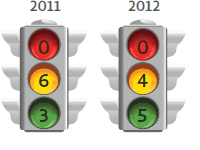 When analyzing the distribution of research dollars across the seven question areas described in the IACC Strategic Plan, research on the biology of ASD (Question 2) accounted for the largest portion of ASD research funding in both 2011 ($73.2 million; 24% of total ASD research funding) and 2012 ($100.3 million; 30% of total ASD research funding). As in previous years, more projects corresponded to Question 2 than any other question in the Strategic Plan, comprising 399 projects (32% of all projects) in 2011, and 461 projects (35% of all projects) in 2012.
When analyzing the distribution of research dollars across the seven question areas described in the IACC Strategic Plan, research on the biology of ASD (Question 2) accounted for the largest portion of ASD research funding in both 2011 ($73.2 million; 24% of total ASD research funding) and 2012 ($100.3 million; 30% of total ASD research funding). As in previous years, more projects corresponded to Question 2 than any other question in the Strategic Plan, comprising 399 projects (32% of all projects) in 2011, and 461 projects (35% of all projects) in 2012.
Progress was made for each of the nine objectives under Question 2. In 2011, three objectives were considered completed in terms of meeting the budget recommendations in their respective research areas, while six of the objectives were partially completed. In 2012, the number of objectives completed increased to five, while four of the objectives were partially completed. A full list of Question 2 objectives and details of their progress can be found in Table 6.
Although all objectives in Question 2 showed some progress in terms of funded research, the majority of research projects that were categorized under this question did not fit into any of the specific Question 2 research objectives and were categorized as Core/Other. In 2011, 56% ($41.1 million) of funding for Question 2 went to projects that were not specific to Question 2 objectives (Figure 22). In 2012, 49% ($48.9 million) of funding went to projects that were not specific to Question 2 objectives (Figure 22). This is similar to levels observed in previous IACC autism research portfolio analyses. Question 2 encompasses a very broad range of basic research on ASD, some of which is not captured in the question’s nine research objectives, which focus on gap areas prioritized by the Committee. The Question 2 projects designated as Core/Other correspond to research areas that were already established and/or well-funded at the time the Strategic Plan was developed, as well as areas of emerging science that may not have been captured in the Strategic Plan objectives. This is in large part due to several areas of established, ongoing research that fit within this Question, including basic research on autism that involves the molecular neuroscience, brain structure and function, and behavioral and cognitive neuroscience fields. Figure 22 provides a snapshot of the range of research included in the group of Question 2 projects that were designated as Core/Other.
The two objectives receiving the largest portion of Question 2 funding (2.S.D and 2.S.G) have remained consistent across portfolio analyses since 2009. Almost a fifth of funding associated with Question 2 in both 2011 (17%; $12.4 million) and 2012 (18%; $18.5 million) was devoted to understanding the underlying biology of genetic conditions related to ASD, including Rett syndrome, fragile X syndrome, and tuberous sclerosis complex (2.S.D). Projects investigating a link between specific genotypes and functional or structural phenotypes (2.S.G) received 15% ($11.1 million) of funding in 2011 and 16% ($15.6 million) of funding in 2012. This research includes studies examining genotypes and phenotypes, alterations in language function and development, or specific regional differences in brain structure compared to those who have other genotypes.
While the IACC Portfolio Analysis attempts to capture all activity categorized under the various objectives of the Strategic Plan, in some cases it is difficult to do so. For example, samples collected by the National Institute of Child Health and Human Development (NICHD) Brain and Tissue Bank for Developmental Disorders are an important resource for ASD research. However, because the tissue bank is not ASD-specific, funding of this initiative— which includes outreach with the aim of increasing tissue donation, which would fall under Objective 2.S.C— is not included in the Portfolio Analysis. Thus, though this project contributes to Objective 2.S.C., its funding is not counted toward the total, and this in turn reduces the extent to which objectives such as 2.S.C appear completed.
Examples of Topics addressed by Projects in Core/Other:
- Role of genes and molecular pathways in ASD
- Structure, development, and function of brain regions in aspects of ASD
- Neural circuitry underlying ASD
- Cognition, learning, sensory perception and social behaviors in ASD
Figure 22. Roughly half of ASD research projects in Question 2 were coded to specific objectives; those that did not fit within the IACC Strategic Plan objectives were coded as Core/Other. Examples of topics addressed by projects in Core/Other are listed above.
Question 2 Subcategory Analysis
Due to the large proportion of research in Question 2 that could not be assigned to a particular objective, the subcategory analysis was particularly useful in understanding the distribution of research on the underlying mechanisms of ASD. Research in this area covers a broad array of science, and therefore Question 2, which was approximately $73.2 million of total funding in 2011 and 100.3 million in 2012, was divided into several subcategories. These include: Cognitive studies; Computational science; Co-occurring conditions; Developmental trajectory; Immune/Metabolic pathways; Molecular pathways; Neural systems; Neuropathology; Sensory and motor function; and Subgroups/Biosignatures (Figures 23 and 24).
The largest portion of Question 2 funding in 2011 (32%) and 2012 (35%) was devoted to research on Molecular pathways (systems of genes, proteins, and other molecules) involved in ASD and related disorders (such as fragile X, Rett syndrome, etc.), including projects that explore these pathways using animal model systems that mimic various aspects of ASD. Research exploring the Neural systems involved in ASD was the second largest research investment with 18% of funding in both 2011 and 2012. These studies typically use imaging techniques such as MRI (magnetic resonance imaging) and EEG (electroencephalography) to look at differences in brain structure, neural circuitry, and regional activation associated with ASD. Projects aiming to identify ASD Subgroups/Biosignatures accounted for 15% of Question 2 funding in 2011 and 2012. Research into the Developmental trajectory of ASD, which includes longitudinal studies that follow social, behavioral, and physical development over time, accounted for 7% and 10% of research funding in 2011 and 2012 respectively. Projects investigating Sensory and motor function in ASD accounted for 7% in 2011 and 5% in 2012 of research funding. Studies focusing on Co-occurring conditions, such as sleep disorders, epilepsy, and gastrointestinal disruption, represented 6% and 3% of funding in 2011 and 2012 respectively. In 2011, Cognitive studies accounted for 5% of ASD research funding, and Computational science projects accounted for 4%; in 2012, each accounted for 4% of ASD research. Research into Immune/Metabolic pathways disruptions associated with ASD corresponded to 3% of funding in 2011 and 2012. Finally, Neuropathology studies using postmortem brain tissue accounted for 2% of funding in both 2011 and 2012. Figures 23 and 24 also list Federal and private funders of research that fit within the Strategic Plan Question 2 category.
2011 Question 2: Biology – Funding by Subcategories
Total Funding: $73,223,388
Number of Projects: 399
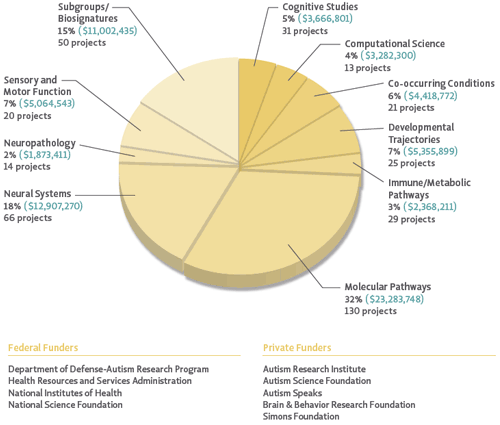
Figure 23. In order to adequately describe the breadth of research represented by Question 2 (Biology), a large number of subcategories were used when grouping projects. In 2011, the subcategory with the largest portion of funding was Molecular pathways (32%), followed by Neural systems (18%), Subgroups/Biosignatures (15%), Developmental trajectories and Sensory and motor function (both 7%), Co-occurring conditions (6%), Cognitive studies (5%) and Computational science (4%) Immune/Metabolic pathways (3%), and finally Neuropathology (2%). Federal and private funders of research fitting within Strategic Plan Question 2 are indicated at the bottom of the figure.
2012 Question 2: Biology – Funding by Subcategories
Total Funding: $100,254,414
Number of Projects: 461
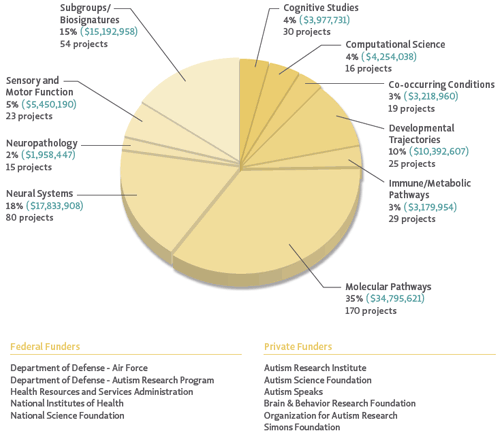
Figure 24. In 2012, the subcategory with the largest portion of funding was Molecular pathways (35%), followed by Neural systems (18%), Subgroups/Biosignatures (15%), Developmental trajectories (10%), Sensory and motor function (5%), Cognitive studies and Computational science (both 4%), Co-occurring conditions and Immune/Metabolic pathways (both 3%) and lastly Neuropathology (2%). Federal and private funders of research fitting within Strategic Plan Question 2 are indicated at the bottom of the figure.
Progress Made on Question 2 from 2008-2012
Table 6 describes the progress made on the nine research objectives within Question 2 over the five-year period from 2008-2012. The table also provides details regarding the status of funding for each objective, the status of research/scientific progress in each objective area, and information about remaining gaps, needs, and opportunities in each research area. Figure 25 shows the trend in Question 2 funding over time. Overall, funding for research projects related to Question 2 was relatively higher than most other areas. Projects corresponding to Question 2 comprised the largest proportion of overall ASD research funding in 2010-2012 and showed a steady increase overall from 2008-2012.
In summary, progress has been made in funding projects to address the research needs described in all nine of the Question 2 objectives. While nearly half of funding was assigned to projects that correspond to the Question 2 objectives, the other half was not specific to any objective and was invested in Core/Other research activities, which encompass long-standing investments in research toward understanding the biology of autism as well as research in newly emerging areas of science.
Figure 25. Question 2 ASD Research Funding from 2008-2012. Overall, funding for Question 2 increased over the five-year span.
Question 2 Multiyear Funding Table
| IACC Strategic Plan Objectives | Funding | |||||
|---|---|---|---|---|---|---|
| Year | 2008 | 2009 | 2010 | 2011 | 2012 | Total |
IACC Strategic Plan ObjectivesSupport at least four research projects to identify mechanisms of fever, metabolic and/or immune system interactions with the central nervous system that may influence ASD during prenatal-postnatal life by 2010 (Fever studies to be started by 2012). IACC Recommended Budget: $9,800,000 over 4 years |
Funding 20082.2 |
Funding 20092.S.A |
Funding 20102.S.A |
Funding 20112.S.A |
Funding 20122.S.A |
Funding Total$16,997,853 |
2.S.A. Funding: The recommended budget for this objective was met. Progress: Many projects were funded in this area (approximately 20-30 per year), but the field is still developing, and emphasis on this objective should continue in the future. Scientific advances have been made in linking maternal innate immune function and immune-system challenge to aspects of ASD. Methodological advances in the field include the development of animal models for study of the role of the immune system in ASD and PET ligands for imaging microglial activation. Remaining Gaps, Needs, and Opportunities: There is a need for a well-designed, multi-site clinical study of clinical effects of fever and to develop standard measures of fever and behavioral/cognitive outcomes. Questions about fever could be integrated into funded epidemiological studies. There is also interest in further work on metabolic and mitochondrial issues, but in order for this work to be done, there is a need for validation and standardization of measures for assessment of oxidative stress and mitochondrial function. More guidance is needed on the key questions for this field to answer – a workshop to define these methodologies may be helpful. One of the key questions is to determine whether it is the body temperature associated with fever or some consequence of immune activation and production of the febrile state that leads to amelioration of cognitive function. |
||||||
| IACC Strategic Plan Objectives | Funding | |||||
| Year | 2008 | 2009 | 2010 | 2011 | 2012 | Total |
IACC Strategic Plan ObjectivesLaunch three studies that specifically focus on the neurodevelopment of females with ASD, spanning basic to clinical research on sex differences by 2011. IACC Recommended Budget: $8,900,000 over 5 years |
Funding 20082.3 |
Funding 20092.S.B |
Funding 20102.SB |
Funding 20112.S.B |
Funding 20122.S.B |
Funding Total$5,856,783 |
2.S.B. Funding: The recommended budget was partially met. Progress: More than the minimum three studies recommended were launched, but further work is needed in this area. Studies have found that females with ASD often have a higher burden of ASD genetic risk mutations than males, suggesting a genderassociated protective effect in females. Research on factors protecting females from developing ASD symptoms even when challenged with genetic mutations that lead to ASD in boys may help to identify approaches to prevent development of ASD symptoms in both genders. Remaining Gaps, Needs, and Opportunities: Studies of protective and compensatory effects in females and differential response to treatment based on gender are promising areas that could help with future prevention and effective, personalized treatment efforts. Beyond genetic differences, it is important to determine whether other biological features, such as differences in neuropathology, are found in the two sexes. |
||||||
| IACC Strategic Plan Objectives | Funding | |||||
| Year | 2008 | 2009 | 2010 | 2011 | 2012 | Total |
IACC Strategic Plan ObjectivesIdentify ways to increase awareness among the autism spectrum community of the potential value of brain and tissue donation to further basic research by 2011. IACC Recommended Budget: $1,400,000 over 2 years |
Funding 20082.4 |
Funding 20092.S.C |
Funding 20102.S.C |
Funding 20112.S.C |
Funding 20122.S.C |
Funding Total$856,031 |
2.S.C. Funding: The recommended budget was partially met. Progress: Loss of autism brain samples due to a freezer malfunction at a major brain bank in 2012 has caused a loss of progress in ASD research. Thus, there is a need for new samples to replace those that were lost and to begin expanding the amount of brain tissue available for ASD research. The Autism BrainNet initiative is a multi-site, privately funded effort that will target autism specifically and will include an autismspecific brain donation outreach campaign that addresses this objective. NIH launched the NIH Neurobiobank ($5 million), which includes samples for research on autism as well as other brain disorders, and has an associated online publication "Why Brain Donation? A Legacy of Hope" to increase awareness about brain donation. Both of these initiatives are not yet reflected in the Portfolio Analysis, because they began in 2013. In addition to these new brain banking efforts, the NICHD Brain and Tissue Bank produced a video for their website to generally increase awareness the potential value of brain and tissue donation to further basic research on neurodevelopmental and pediatric conditions. Since the effort is not autism-specific, it was not captured in the portfolio analysis. Remaining Gaps, Needs, and Opportunities: There is an ongoing and urgent need to raise awareness of the importance of brain and tissue donation for research, to standardize the methodology of collection and to increase the supply of such tissues. Autism BrainNet, a private outreach and postmortem brain donation program dedicated to research on autism and related disorders will integrate the Autism Tissue Program (ATP) with collection sites at Mount Sinai School of Medicine, the University of Texas Southwestern Medical School, and the University of California, Davis MIND Institute. |
||||||
| IACC Strategic Plan Objectives | Funding | |||||
| Year | 2008 | 2009 | 2010 | 2011 | 2012 | Total |
IACC Strategic Plan ObjectivesLaunch three studies that target improved understanding of the underlying biological pathways of genetic conditions related to autism (e.g., Fragile X, Rett syndrome, tuberous sclerosis complex) and how these conditions inform risk assessment and individualized intervention by 2012. IACC Recommended Budget: $9,000,000 over 5 years |
Funding 2008N/A |
Funding 20092.S.D |
Funding 20102.S.D |
Funding 20112.S.D |
Funding 20122.S.D |
Funding Total$53,147,645 |
2.S.D. Funding: The recommended budget was met. Significantly more than the recommended minimum budget was allocated to projects specific to this objective. Progress: A large number of projects were funded that address this objective. Investment in this area has doubled since 2009, and in 2013, NIH began funding an ACE center focused on tuberous sclerosis. Much is being learned about conditions related to autism that can be applied to autism. This objective is on track. Remaining Gaps, Needs, and Opportunities: The next step will be to translate findings in this area into clinically useful therapies. |
||||||
| IACC Strategic Plan Objectives | Funding | |||||
| Year | 2008 | 2009 | 2010 | 2011 | 2012 | Total |
IACC Strategic Plan ObjectivesLaunch three studies that target the underlying biological mechanisms of co-occurring conditions with autism, including seizures/epilepsy, sleep disorders, wandering/elopement behavior, and familial autoimmune disorders, by 2012. IACC Recommended Budget: $9,000,000 over 5 years |
Funding 2008N/A |
Funding 20092.S.E |
Funding 20102.S.E |
Funding 20112.S.E |
Funding 20122.S.E |
Funding Total$16,531,078 |
2.S.E. Funding: The recommended budget for this objective was met. Progress: More than twenty projects were funded that were specific to this objective. Scientific advances in this area include mechanistic and mutation linkages of epilepsy and ASD-like behaviors, as well as circadian rhythm disruptions downstream of ASDassociated mutations. Remaining Gaps, Needs, and Opportunities: While studies on co-occurringconditions have been initiated, a greater depth of understanding is needed. Further efforts are needed, especially on wandering, metabolic and immune conditions related to ASD, as well as a systems-biology approach to understand how these co-occurring conditions are related to ASD. In order to more accurately assess progress, wandering/elopement should be considered separately from seizures/epilepsy/sleep. Familial autoimmune disorders could be moved to 2.S.A to be grouped with other immunerelated issues. |
||||||
| IACC Strategic Plan Objectives | Funding | |||||
| Year | 2008 | 2009 | 2010 | 2011 | 2012 | Total |
IACC Strategic Plan ObjectivesLaunch two studies that focus on prospective characterization of children with reported regression to investigate potential risk factors by 2012. IACC Recommended Budget: $4,500,000 over 5 year |
Funding 2008N/A |
Funding 20092.S.F |
Funding 20102.S.F |
Funding 20112.S.F |
Funding 20122.S.F |
Funding Total$993,134 |
2.S.F. Funding: The recommended budget was partially met. Progress: The objective was accomplished as the committee intended. NIH held a workshop, The number of recommended projects has been met and progress is being made, but further work is needed to understand how autism develops. Some recent data suggest that regression may be more of a continuum than a distinct type of autism, and several studies have provided new descriptions of ASD developmental trajectories. However, other studies have found some differences between children with reported regression vs. children without reported regression. Remaining Gaps, Needs, and Opportunities: Further work is needed to better understand subtypes and potential biomarkers. High-risk siblings may present an opportunity for studying regression prospectively. |
||||||
| IACC Strategic Plan Objectives | Funding | |||||
| Year | 2008 | 2009 | 2010 | 2011 | 2012 | Total |
IACC Strategic Plan ObjectivesSupport five studies that associate specific genotypes with functional or structural phenotypes, including behavioral and medical phenotypes (e.g., nonverbal individuals with ASD and those with cognitive impairments) by 2015. IACC Recommended Budget: $22,600,000 over 5 years |
Funding 2008N/A |
Funding 20092.S.G |
Funding 20102.S.G |
Funding 20112.S.G |
Funding 20122.S.G |
Funding Total$41,777,028 |
2.S.G. Funding: The recommended budget was met. Significantly more than the recommended minimum budget was allocated to projects specific to this objective. Progress: Over 40 projects have been funded in this area, and the projects cover the areas described, so the objective appears to be on track. Remaining Gaps, Needs, and Opportunities: With so many studies initiated, the next step is to encourage multi-site collaboration in order to achieve the large number of subjects required for meaningful data interpretation. |
||||||
| IACC Strategic Plan Objectives | Funding | |||||
| Year | 2008 | 2009 | 2010 | 2011 | 2012 | Total |
IACC Strategic Plan ObjectivesComplete a large-scale, multidisciplinary, collaborative project that longitudinally and comprehensively examines how the biological, clinical, and developmental profiles of individuals, with a special emphasis on females, youths, and adults with ASD, change over time as compared to typically developing people by 2020. IACC Recommended Budget: $126,200,000 over 12 years |
Funding 20082.5 |
Funding 20092.L.A |
Funding 20102.L.A |
Funding 20112.L.A |
Funding 20122.L.A |
Funding Total$20,661,641 |
2.L.A. Funding: The recommended budget was partially met. Progress: Several projects have been funded in this area, and the ACE Network continues to collect data relevant to this objective. Remaining Gaps, Needs, and Opportunities: Though this research is underway, more clinical studies are needed over a longer trajectory to identify issues faced as people with ASD age, especially with regard to risk factors for other medical conditions. Another remaining need is that of standardization of data collection and analysis methods. |
||||||
| IACC Strategic Plan Objectives | Funding | |||||
| Year | 2008 | 2009 | 2010 | 2011 | 2012 | Total |
IACC Strategic Plan ObjectivesLaunch at least three studies that evaluate the applicability of ASD phenotype and/or biological signature findings for performing diagnosis, risk assessment, or clinical intervention by 2015. IACC Recommended Budget: $7,200,000 over 5 years |
Funding 2008N/A |
Funding 20092.L.B |
Funding 20102.L.B |
Funding 20112.L.B |
Funding 20122.L.B |
Funding Total$3,628,406 |
2.L.B. Funding: The recommended budget was partially met. Progress: Imaging studies have developed activity signatures of the ASD brain. While more than 3 studies were launched, more funding and work in this area are needed. Remaining Gaps, Needs, and Opportunities: This objective also requires standardization of data collection and analysis methods, as well as collaboration among investigators to pool data. Increased emphasis must be placed on conducting biological evaluations of very young children at risk for ASD and on collecting biological samples from these young children, to enable research into the establishment of biomarkers or risk markers in this population. |
||||||
| IACC Strategic Plan Objectives | Funding | |||||
| Year | 2008 | 2009 | 2010 | 2011 | 2012 | Total |
IACC Strategic Plan ObjectivesNot specific to any objective (Core/Other Activities) |
Funding 20081. Core/Other Activities |
Funding 20091. Core/Other Activities |
Funding 20101. Core/Other Activities |
Funding 20111. Core/Other Activities |
Funding 20121. Core/Other Activities |
Funding Total$203,144,324 |
IACC Strategic Plan Objectives†Total funding for Question 2† |
Funding 2008$40,621,403 |
Funding 2009$63,252,949 |
Funding 2010$91,260,349 |
Funding 2011$73,223,388 |
Funding 2012$100,254,414 |
Funding Total$368,612,503* |
Question 2 Multiyear Funding Table, see appendix for a color-coding key and further detail.
*This total reflects all funding for projects aligned to current objectives in the 2011 IACC Strategic Plan and incorporates funding for projects that may have been coded differently in previous versions of the Plan.
†The totals reflect the funding and projects coded to this Question of the Strategic Plan in the particular year indicated at the top of the column. When reading each column vertically, please note that the projects and funding associated with each objective for 2008 may not add up to the total at the bottom of the column; this is due to revisions of the Strategic Plan that caused some objectives to be shifted to other Questions under the Plan. The projects and funding associated with these reclassified objectives are now reflected under the Question in which they appear in the 2011 Strategic Plan.
Table 5. Multiyear Funding Table for Question 2.6
6The numbers in this table have been updated since the 2013 IACC Strategic Plan has been published.
Question 3: Risk Factor
Aspirational Goal: Causes of ASD will be discovered that inform prognosis and treatments and lead to prevention/preemption of the challenges and disabilities of ASD.
Research Focus of Question 3
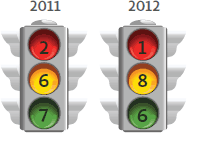 Question 3 ("What caused this to happen and can it be prevented?") focuses on the risk factors associated with the development of ASD. Research related to Question 3 looks at the role of genetics, epigenetics, and the environment in the development of ASD, as well as the interactions between risk factors. Question 3 objectives address topics such as the need to develop improved approaches to study environmental exposures and gene-environment interactions, and to explore the potential roles of the microbiome and epigenetics on etiology. Also included are studies of risk factors and protective factors (factors that may protect an individual from developing ASD, even in the presence of other risk factors).
Question 3 ("What caused this to happen and can it be prevented?") focuses on the risk factors associated with the development of ASD. Research related to Question 3 looks at the role of genetics, epigenetics, and the environment in the development of ASD, as well as the interactions between risk factors. Question 3 objectives address topics such as the need to develop improved approaches to study environmental exposures and gene-environment interactions, and to explore the potential roles of the microbiome and epigenetics on etiology. Also included are studies of risk factors and protective factors (factors that may protect an individual from developing ASD, even in the presence of other risk factors).
Analysis of Question 3 Portfolio 2011-2012
Research on risk factors associated with ASD (Question 3) accounted for 20% ($60.2 million) and 17% ($56.5 million) of the total funding in 2011 and 2012 respectively. In 2011, Question 3 contained 148 projects (12.1% of all projects), and in 2012 it had 162 projects (12.3% of all projects).
In 2011, progress was made on all but two of the 15 Question 3 objectives. Seven objectives were considered completed, while six objectives were partially completed. In 2012, six objectives were completed, and eight were partially completed. One objective in Question 3 did not have any active projects throughout 2011 and 2012. A full list of objectives and their progress can be found in Table 7.
Nearly all projects in Question 3 were assigned to a particular objective. In 2011, only 1% ($0.7 million) of the Question 3 funding was distributed to projects that were Core/Other (Figure 26). Similarly, in 2012, 1% ($0.3 million) of the Question 3 funding was distributed to projects that were categorized to Core/Other (Figure 26).
As in previous years, the Question 3 objective that received the largest proportion of funding in 2011 (42%, $25.4 million) and 2012 (41%, $23.0 million) focused on identifying genetic risk factors for ASD (3.L.B). This was followed by funding for surveillance and epidemiological studies to collect data on environmental factors during preconception and prenatal and early postnatal development, as well as genetic data (3.L.D). This objective accounted for 19% ($11.6 million) of the overall funding for Question 3 in 2011 and 24% ($13.5 million) in 2012. Research on epigenetics (3.S.J) received 9% ($5.3 million) of the funding in 2011 and 11% ($6.1 million) in 2012, and projects focusing on gene-environment interactions (3.S.C) received 9% ($5.7 million) and 6% ($3.6 million) in 2011 and 2012 respectively. Research on special populations with the aim of understanding environmental risk factors (3.S.H) accounted for 8% ($4.7 million) of funding in 2011 and 7% ($4.1 million) in 2012; prospective studies of the pregnancies of mothers who already have one child with ASD (3.L.A) received 5% ($2.9 million) in both 2011 and 2012. Genome-wide association studies to find candidate genes for autism (3.S.A) received 4% ($2.2 million) and 3% ($1.7 million) in 2011 and 2012 respectively. The investigation of possible links between environmental factors and ASD subtypes (3.L.C), research to identify subpopulations susceptible to different environmental factors (3.S.E), studies on environmental factors identified in the 2007 IOM report (3.S.F), investigation of the microbiome (3.S.I), and the development of model systems to explore environmental risks (3.S.K), each received approximately 1% or less of the funding for Question 3 in 2011 and 2012. In 2011, a workshop hosted by the National Institute of Environmental Health Sciences (NIEHS) was convened to explore bioinformatics approaches to identify environmental risks; thus, Objective 3.S.G. was completed. The workshop reflected less than 1% of the overall funding for Question 3.
In 2011, two of the Question 3 objectives did not have assigned activities. One of these objectives calls for development of measures to identify markers of environmental exposure in biospecimens (3.S.B), and another calls for efforts to ensure that studies of environmental exposures and ASD include racially and ethnically diverse populations (3.S.D). In 2012, Objective 3.S.D remained inactive; however, with the presence of one new project, Objective 3.S.B became active for the first time since 2008. For Objective 3.S.D, there are projects coded to other objectives in the portfolio that may partially meet the requirements, but because projects can only be coded to one objective, that funding is not reflected in the 3.S.D total. Even if that funding were to be considered, the objective would still be unmet.
Examples of Topics addressed by Projects in Core/Other:
- Studies of genetic risk for ASD using epidemiologic approaches or postmortem brain tissue
Figure 26. Most ASD research projects in Question 3 were coded to specific objectives; those that did not fit within the IACC Strategic Plan objectives were coded as Core/Other. Examples of topics addressed by projects in Core/Other are listed above.
Question 3 Subcategory Analysis
Projects in Question 3, which made up nearly $60.2 million of total funding in 2011 and $56.5 million in 2012, were divided into four subcategories to understand the funding distribution across the research areas relating to understanding and identifying risk factors for ASD. These subcategories include: Environmental risk factors; Epigenetics; Gene-Environment studies; and Genetic risk factors (Figures 27 and 28).
The largest portion of Question 3 funding was devoted to research into Genetic risk factors in both 2011 (46%) and in 2012 (43%). The second largest research investment was investigating the role of environmental risk factors in the presence of genetic susceptibility (Gene-Environment) which accounted for 34% in 2011 and 37% in 2012. Projects that considered only environmental risk factors (Environmental risk factors) accounted for 11% and 9% of Question 3 funding in 2011 and 2012 respectively. Projects on Epigenetics, which include studies of DNA modifications such as methylation that do not affect amino acid sequence (i.e., not genetic mutations), received 10% in 2011 and 11% in 2012 of the funding. It is thought that epigenetic changes are one way the environment may influence gene expression to increase or decrease the chances of developing ASD. When considered together, the three subcategories that take environmental factors into account (Environment risk factors, Gene-Environment, and Epigenetics) accounted for over half (55% and 57% in 2011 and 2012 respectively) of the funding associated with Question 3. Figures 27 and 28 also list Federal and private funders of research that fits within the Strategic Plan Question 3 category.
2011 Question 3: Risk Factor – Funding by Subcategories
Total Funding: $60,209,628
Number of Projects: 148
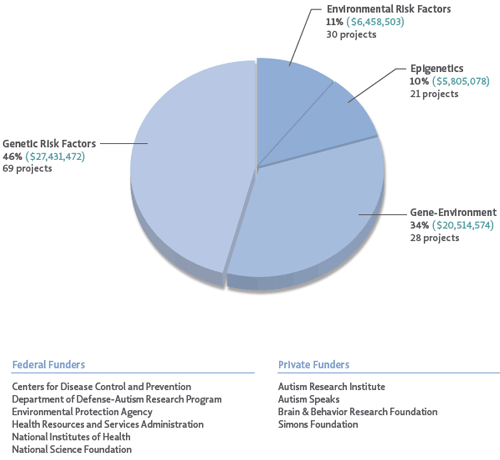
Figure 27. Projects aligning with Question 3 (Risk Factors) were divided into four subcategories. In 2011, Genetic risk factors accounted for the majority of research funding (46%), followed by studies focused on Gene-Environment interactions (34%). Studies on Environmental risk factors received 11% of the funding for projects within Question 3, and Epigenetics studies received 10%. Federal and private funders of research fitting within Strategic Plan Question 3 are indicated at the bottom of the figure.
2012 Question 3: Risk Factor – Funding by Subcategories
Total Funding: $56,487.025
Number of Projects: 162
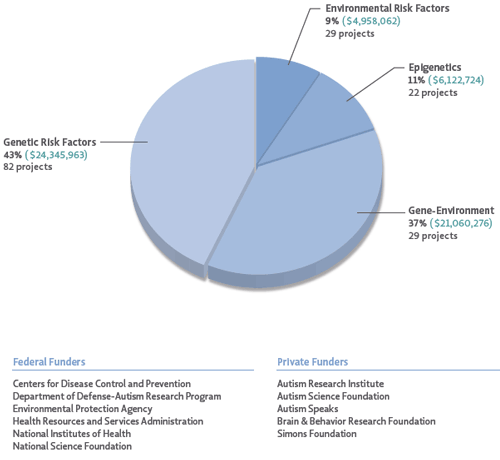
Figure 28. In 2012, research on Genetic risk factors (43%) and Gene-Environment interactions (37%) received the greatest portion of research funding among projects assigned to Question 3 (Risk Factors). This was followed by Epigenetics studies (11%), and studies on Environmental risk factors (9%). Federal and private funders of research fitting within Strategic Plan Question 3 are indicated at the bottom of the figure.
Progress Made on Question 3 from 2008-2012
Table 7 describes the progress made on the 15 research objectives within Question 3 over the five-year period from 2008-2012. The table also provides details regarding the status of funding for each objective, the status of research/scientific progress in each objective area, and information about remaining gaps, needs, and opportunities in each research area. Figure 29 shows the trend in Question 3 funding over time. In 2008, research relating to Question 3 was the highest funded area, but over the five years studied, funding levels decreased to below that of Question 2 and 4.
While research on risk factors has been funded at a higher level than some other areas of research (it was the most highly funded area in 2008-2009), there has been a significant overall decrease in funding in the fiveyear period from 2008-2012 (Figure 29). All 15 Question 3 objectives have had some funded research projects from 2008-2012. Nine out of 15 objectives showed a decrease in number of projects over the five period, three objectives showed an increase, and three objectives were flat or only required a single project (Table 7).
Figure 29. Question 3 ASD Research Funding from 2008-2012. Though there was a peak in funding in 2009, overall funding for Question 3 decreased over the five-year span.
Question 3 Multiyear Funding Table
| IACC Strategic Plan Objectives | Funding | |||||
|---|---|---|---|---|---|---|
| Year | 2008 | 2009 | 2010 | 2011 | 2012 | Total |
IACC Strategic Plan ObjectivesCoordinate and implement the inclusion of approximately 20,000 subjects for genome-wide association studies, as well as a sample of 1,200 for sequencing studies to examine more than 50 candidate genes by 2011. Studies should investigate factors contributing to phenotypic variation across individuals who share an identified genetic variant and stratify subjects according to behavioral, cognitive, and clinical features. IACC Recommended Budget: $43,700,000 over 4 years |
Funding 20083.2 |
Funding 20093.S.A |
Funding 20103.S.A |
Funding 20113.S.A |
Funding 20123.S.A |
Funding Total$38,587,633 |
3.S.A. Funding: The recommended budget was partially met, and is approaching the recommended budget. Progress: Progress has been made on this objective through the funding of several GWAS and sequencing projects. The current number of 6,000 GWAS subjects falls short of the goal of 20,000, but the number of whole exome sequences far exceeds 1,200, and could also reach 6,000 in the next year. Whole exome sequencing has identified 7-10 candidate genes, and promises to move closer to the goal of 50 in the future. Progress is being made in CNV studies. Overall, the work is on target. Remaining Gaps, Needs, and Opportunities: More subtyping and genotype-phenotype work outside of syndromic forms of autism, as well as natural history studies, are needed. |
||||||
| IACC Strategic Plan Objectives | Funding | |||||
| Year | 2008 | 2009 | 2010 | 2011 | 2012 | Total |
IACC Strategic Plan ObjectivesWithin the highest-priority categories of exposures for ASD, identify and standardize at least three measures for identifying markers of environmental exposure in biospecimens by 2011. IACC Recommended Budget: $3,500,000 over 3 years |
Funding 20083.3 |
Funding 20093.S.B |
Funding 20103.SB |
Funding 20113.S.B |
Funding 20123.S.B |
Funding Total$813,227 |
3.S.B. Funding: The recommended budget was not met; the funding allocated to projects specific to this objective falls far short of the recommendation. Progress: There has been progress on the understanding of exposures, but more work needs to be done to apply this directly to autism research. Progress has made through methodological advances embedded in epidemiological studies funded by NIEHS, but those projects are not captured by the Portfolio Analysis because they are not specific to autism. Remaining Gaps, Needs, and Opportunities: The primary obstacle to completion of this objective has been availability of funding to identify and validate exposure markers. There is a need for biomarkers of exposure; exposomics should be a priority area for future research. |
||||||
| IACC Strategic Plan Objectives | Funding | |||||
| Year | 2008 | 2009 | 2010 | 2011 | 2012 | Total |
IACC Strategic Plan ObjectivesInitiate efforts to expand existing large casecontrol and other studies to enhance capabilities for targeted gene-environment research by 2011. IACC Recommended Budget: $27,800,000 over 5 years |
Funding 20083.4 |
Funding 20093.S.C |
Funding 20103.S.C |
Funding 20113.S.C |
Funding 20123.S.C |
Funding Total$26,903,311 |
3.S.C. Funding: The recommended budget was nearly met, but work still needs to continue on this objective. Progress: The funding allocated to this area so far has primarily supported building infrastructure that can now be expanded to include more subjects, more data, and more analytical projects. Studies such as the MARBLES (Markers of Autism Risk in Babies Learning Early Signs) cohort study and the CHARGE (Childhood Autism Risks from Genetics and the Environment) study are included under this objective. Remaining Gaps, Needs, and Opportunities: Continued benefit will be derived from past investments as these resources are expanded and pooled. |
||||||
| IACC Strategic Plan Objectives | Funding | |||||
| Year | 2008 | 2009 | 2010 | 2011 | 2012 | Total |
IACC Strategic Plan ObjectivesEnhance existing case-control studies to enroll racially and ethnically diverse populations affected by ASD by 2011. IACC Recommended Budget: $3,300,000 over 5 years |
Funding 20083.5 |
Funding 20093.S.D |
Funding 20103.S.D |
Funding 20113.S.D |
Funding 20123.S.D |
Funding Total$188,455 |
3.S.D. Funding: The recommended budget was not met; the funding allocated to projects specific to this objective falls far short of the recommendation. Progress: The UCLA ACE center coded to 3.L.B. reflects some progress on this objective. CADDRE also includes racially diverse participants from multiple urban centers. Overall, however, both funding and outcomes related to this objective are far below the goal. Remaining Gaps, Needs, and Opportunities: There is a need for studies around high exposure, low socioeconomic status populations. |
||||||
| IACC Strategic Plan Objectives | Funding | |||||
| Year | 2008 | 2009 | 2010 | 2011 | 2012 | Total |
IACC Strategic Plan ObjectivesSupport at least two studies to determine if there are subpopulations that are more susceptible to environmental exposures (e.g., immune challenges related to infections, vaccinations, or underlying autoimmune problems) by 2012. IACC Recommended Budget: $8,000,000 over 2 years |
Funding 2008N/A |
Funding 20093.S.E |
Funding 20103.S.E |
Funding 20113.S.E |
Funding 20123.S.E |
Funding Total$3,608,312 |
3.S.E. Funding: The recommended budget was partially met Progress: Several projects were funded in this area, going beyond the minimum recommended by the committee, but the projects have been smaller than what was expected. However, even with smaller studies, a large amount of data has been collected relating to immunological conditions in children and mothers. Remaining Gaps, Needs, and Opportunities: More work is needed to analyze and interpret available data. |
||||||
| IACC Strategic Plan Objectives | Funding | |||||
| Year | 2008 | 2009 | 2010 | 2011 | 2012 | Total |
IACC Strategic Plan ObjectivesInitiate studies on at least 10 environmental factors identified in the recommendations from the 2007 IOM report “Autism and the Environment: Challenges and Opportunities for Research” as potential causes of ASD by 2012. IACC Recommended Budget: $56,000,000 over 2 years (revised in 2010) |
Funding 20083.1 |
Funding 20093.S.F |
Funding 20103.S.F |
Funding 20113.S.F |
Funding 20123.S.F |
Funding Total$10,794,995 |
3.S.F. Funding: The recommended budget was partially met. Progress: There has been a significant decrease in the number of studies related to this objective. Remaining Gaps, Needs, and Opportunities: Further work in this area is needed, and work should focus on identifying the directionality of associations between environmental factors and ASD (causal, reactive, or independent) in order to be applied to prevention and the development of therapeutics. Sophisticated methods that are being applied in other fields need to be brought into autism research. |
||||||
| IACC Strategic Plan Objectives | Funding | |||||
| Year | 2008 | 2009 | 2010 | 2011 | 2012 | Total |
IACC Strategic Plan ObjectivesConvene a workshop that explores the usefulness of bioinformatic approaches to identify environmental risks for ASD by 2011. IACC Recommended Budget: $35,000 over 1 year |
Funding 2008N/A |
Funding 2009N/A |
Funding 20103.S.G |
Funding 20113.S.G |
Funding 20123.S.G |
Funding Total$46,991 |
3.S.G. Funding: The workshop identified in this objective was funded and held by NIEHS in 2011. Progress: A workshop on this topic, “Autism and the Environment: New Ideas for Advancing the Science,” was convened by the National Institute of Environmental Health Sciences (NIEHS) in 2010. (a meeting report is available). Therefore, this objective has been completed. Remaining Gaps, Needs, and Opportunities: Next steps for this area include the need to develop an exposome. A forum for the sharing of new technologies and standardized assessments would also be useful in moving this field forward. |
||||||
| IACC Strategic Plan Objectives | Funding | |||||
| Year | 2008 | 2009 | 2010 | 2011 | 2012 | Total |
IACC Strategic Plan ObjectivesSupport at least three studies of special populations or use existing databases to inform our understanding of environmental risk factors for ASD in pregnancy and the early postnatal period by 2012. Such studies could include:
Emphasis on environmental factors that influence prenatal and early postnatal development is particularly of high priority. Epidemiological studies should pay special attention to include racially and ethnically diverse populations. IACC Recommended Budget: $12,000,000 over 5 years |
Funding 2008N/A |
Funding 2009N/A |
Funding 20103.S.H |
Funding 20113.S.H |
Funding 20123.S.H |
Funding Total$10,281,278 |
3.S.H. Funding: The recommended budget was partially met, and is approaching the recommended budget. Progress: The funded projects cover the objective well; there are 32 projects that are related to this objective, though more projects focus on use of databases than on special populations. A positive element of progress for this objective is the existence of large monitoring databases and projects that capitalize on those resources, such as iCARE and MINERvA. Remaining Gaps, Needs, and Opportunities: While progress is being made in this area, and it must be maintained in order to achieve this objective. |
||||||
| IACC Strategic Plan Objectives | Funding | |||||
| Year | 2008 | 2009 | 2010 | 2011 | 2012 | Total |
IACC Strategic Plan ObjectivesSupport at least two studies that examine potential differences in the microbiome of individuals with ASD versus comparison groups by 2012. IACC Recommended Budget: $1,000,000 over 2 years |
Funding 2008N/A |
Funding 2009N/A |
Funding 20103.S.I |
Funding 20113.S.I |
Funding 20123.S.I |
Funding Total$749,263 |
3.S.I. Funding: The recommended budget was partially met. Progress: The number of projects in this area has been growing, with 6 projects in 2012. The number of funded projects is large relative to the amount of funding, indicating that each of the projects is small, which suggests that these projects will not be sufficient in scope to complete this objective. Remaining Gaps, Needs, and Opportunities: The high cost of required technology could be a barrier to the completion of this objective. These smaller pilot studies are potentially underpowered. The question of sample availability is important for this objective, along with raising researcher awareness of sample repositories. |
||||||
| IACC Strategic Plan Objectives | Funding | |||||
| Year | 2008 | 2009 | 2010 | 2011 | 2012 | Total |
IACC Strategic Plan ObjectivesSupport at least three studies that focus on the role of epigenetics in the etiology of ASD, including studies that include assays to measure DNA methylations and histone modifications and those exploring how exposures may act on maternal or paternal genomes via epigenetic mechanisms to alter gene expression, by 2012. IACC Recommended Budget: $20,000,000 over 5 years |
Funding 2008N/A |
Funding 2009N/A |
Funding 20103.S.J |
Funding 20113.S.J |
Funding 20123.S.J |
Funding Total$16,536,350 |
3.S.J. Funding: The recommended budget was partially met, and the annualized recommended budget targets were met for all 3 years since the objective was introduced; therefore, the funding for this objective is on track. If this funding trend continues, the objective’s recommended budget will be met within the recommended 5 year timeframe. Progress: More than the recommended number of projects have been funded, with 22 projects supported in 2012. This is a growing area of research, and the current momentum in this area should be maintained. Remaining Gaps, Needs, and Opportunities: An important technological need for this objective is the development of robust epigenetic measurements for small biological samples, such a blood spots. A possible barrier to research in this area is the availability and preservation quality of these samples. Large funded studies such as MARBLES might provide an opportunity to collect samples. If samples are made available, that may catalyze research in this area. |
||||||
| IACC Strategic Plan Objectives | Funding | |||||
| Year | 2008 | 2009 | 2010 | 2011 | 2012 | Total |
IACC Strategic Plan ObjectivesSupport two studies and a workshop that facilitate the development of vertebrate and invertebrate model systems for the exploration of environmental risks and their interaction with gender and genetic susceptibilities for ASD by 2012. IACC Recommended Budget: $1,535,000 over 3 years |
Funding 2008N/A |
Funding 2009N/A |
Funding 20103.S.K |
Funding 20113.S.K |
Funding 20123.S.K |
Funding Total$1,287,763 |
3.S.K. Funding: The recommended budget was partially met. However, the yearly funding decreased significantly from 2010-2012. It should be noted that this objective overlaps partially with 2.S.B., which is focused on research on sex differences in ASD, and 4.S.B., which focuses on development of animal models that can be used for understanding molecular and neural pathways that can be targeted by interventions. Genetic pathways that play a role in gender differences and other molecular and neural pathways may interact with environmental factors, so funding for these objectives could reflect progress on the goals of 3.S.K. Progress: Projects by Tychele Turner at Johns Hopkins and Donna Werling at UCLA that are using animal models to investigate sex differences in autism are coded to 2.S.B. The following 2010 workshop sponsored by NIEHS, Autism and the Environment: Advancing the Science, touched on this topic, but it was not the main focus of the workshop. Remaining Gaps, Needs, and Opportunities: The development of animal models for more broad ASD research is coded to question 4, and the use of such models to answer environmental exposure questions is a next step for this objective. |
||||||
| IACC Strategic Plan Objectives | Funding | |||||
| Year | 2008 | 2009 | 2010 | 2011 | 2012 | Total |
IACC Strategic Plan ObjectivesConduct a multi-site study of the subsequent pregnancies of 1,000 women with a child with ASD to assess the impact of environmental factors in a period most relevant to the progression of ASD by 2014. IACC Recommended Budget: $11,100,000 over 5 years |
Funding 20083.7 |
Funding 20093.L.A |
Funding 20103.L.A |
Funding 20113.L.A |
Funding 20123.L.A |
Funding Total$15,194,483 |
3.L.A. Funding: The recommended budget for this objective was met, but emphasis on this objective should continue in the future. Progress: The Group is concerned about the lack of continued funding for EARLI. More positively, projects analyzing the previously collected EARLI data are in process. Also, the MARBLES project contributes toward the goal of studying the interaction of genetic and environmental factors beginning during pregnancy, but, since it is not a multi-site study, and is also a continuation of an existing study funded as a pilot under a UC Davis Children’s Center grant, funding for MARBLES is coded to 3.S.C., which overlaps somewhat with this objective. Remaining Gaps, Needs, and Opportunities: A barrier to this type of work is the extremely high cost of building the necessary infrastructure. With MARBLES and previously with EARLI, there has been some progress on infrastructure. It is important to maintain these cohorts where possible, to collect a wide range of samples, and to use them for multiple studies to capitalize on investments made. |
||||||
| IACC Strategic Plan Objectives | Funding | |||||
| Year | 2008 | 2009 | 2010 | 2011 | 2012 | Total |
IACC Strategic Plan ObjectivesIdentify genetic risk factors in at least 50% of people with ASD by 2014. IACC Recommended Budget: $33,900,000 over 6 years |
Funding 20083.8 |
Funding 20093.LB |
Funding 20103.L.B |
Funding 20113.L.B |
Funding 20123.L.B |
Funding Total$169,806,458 |
3.L.B. Funding: The recommended budget was met. Significantly more than the recommended minimum budget was allocated to projects specific to this objective. Progress: Further work is needed to identify genetic risk factors in at least 50% of people. Currently, whole exome analysis predicts that a genetic risk factor can be identified for 20% of people; inclusion of CNV data might push this toward 30%. Remaining Gaps, Needs, and Opportunities: The initial budget recommendation for this objective was made based on the assumption that GWAS studies would provide risk factor identification, but sequencing has proven more fruitful. Since this technique is more expensive, a higher budget will be required to meet the goal of 50%. |
||||||
| IACC Strategic Plan Objectives | Funding | |||||
| Year | 2008 | 2009 | 2010 | 2011 | 2012 | Total |
IACC Strategic Plan ObjectivesDetermine the effect of at least five environmental factors on the risk for subtypes of ASD in the prenatal and early postnatal period of development by 2015. IACC Recommended Budget: $25,100,000 over 7 years |
Funding 20083.6 |
Funding 20093.L.C |
Funding 20103.L.C |
Funding 20113.LC |
Funding 20123.L.C |
Funding Total$5,349,089 |
3.L.C. Funding: The recommended budget was partially met, and several projects were funded, but it appears there is a downward trend in funding for these projects over time. This objective partially overlaps with 3.L.A. Progress: Epidemiological studies coded to other objectives (e.g., EARLI) may also represent progress in this area. Remaining Gaps, Needs, and Opportunities: A barrier to the completion of this objective is the undefined nature of ASD subtypes, both phenotypically and etiologically, lack of prenatal samples, and the lack of longitudinal follow-up of at-risk subgroups. This field is still developing and needs support. |
||||||
| IACC Strategic Plan Objectives | Funding | |||||
| Year | 2008 | 2009 | 2010 | 2011 | 2012 | Total |
IACC Strategic Plan ObjectivesSupport ancillary studies within one or more large-scale, population-based surveillance and epidemiological studies, including United States populations, to collect data on environmental factors during preconception, and during prenatal and early postnatal development, as well as genetic data, that could be pooled (as needed) to analyze targets for potential gene/environment interactions by 2015. IACC Recommended Budget: $44,400,000 over 5 years |
Funding 20083.9 |
Funding 20093.L.D |
Funding 20103.L.D |
Funding 20113.L.D |
Funding 20123.L.D |
Funding Total$63,013,714 |
3.L.D. Funding: The recommended budget was met. Significantly more than the recommended minimum budget was allocated to projects specific to this objective. Progress: The funds allocated to this objective to date have been used for data collection and the development of infrastructure, with most of the studies coded to this area relating to CDC’s CADDRE program. Remaining Gaps, Needs, and Opportunities: Continued funding will be needed to support data analysis. Both molecular and environmental data are needed. |
||||||
| IACC Strategic Plan Objectives | Funding | |||||
| Year | 2008 | 2009 | 2010 | 2011 | 2012 | Total |
IACC Strategic Plan ObjectivesNot specific to any objective (Core/Other Activities) |
Funding 20083. Core/Other Activities |
Funding 20093. Core/Other Activities |
Funding 20103. Core/Other Activities |
Funding 20113. Core/Other Activities |
Funding 20123. Core/Other Activities |
Funding Total$17,656,815 |
IACC Strategic Plan Objectives†Total funding for Question 3† |
Funding 2008$82,846,620 |
Funding 2009$100,043,216 |
Funding 2010$81,231,647 |
Funding 2011$60,209,628 |
Funding 2012$56,487,025 |
Funding Total$380,818,136 |
Table 7. Multiyear Funding Table for Question 3.
Question 4: Treatment and Interventions
Aspirational Goal: Interventions will be developed that are effective for reducing both core and associated symptoms, for building adaptive skills, and for maximizing quality of life and health for people with ASD
Research Focus of Question 4
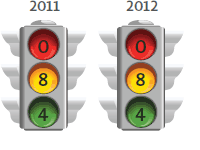 Question 4 asks “Which treatments and interventions will help?” and covers a range of intervention approaches currently being considered, including pharmacological, behavioral, educational, and alternative/complementary/integrative medicine approaches. Research in this field encompasses the development of new treatments using early stage animal models and small-scale experiments as well as full-scale clinical trials. Question 4 also includes studies to assess the safety and effectiveness of treatments already in use in the community.
Question 4 asks “Which treatments and interventions will help?” and covers a range of intervention approaches currently being considered, including pharmacological, behavioral, educational, and alternative/complementary/integrative medicine approaches. Research in this field encompasses the development of new treatments using early stage animal models and small-scale experiments as well as full-scale clinical trials. Question 4 also includes studies to assess the safety and effectiveness of treatments already in use in the community.
Analysis of Question 4 Portfolio 2011-2012
Research assigned to Question 4 received 20% ($60.8 million) of total ASD research funding in 2011, and 19% ($64.1 million) of ASD research funding in 2012. Question 4 included 260 projects in 2011 and 270 projects in 2012, representing 21% of the total number of projects reported in both years.
Progress was made for all of the Question 4 objectives in 2011 and 2012, with four objectives considered completed, and the remaining eight objectives showing progress. The majority of the projects assigned to Question 4 fit into the Question 4 objectives, but in 2011, 8% ($4.8 million) of the funding went to projects designated as Core/Other, and in 2012, 6% (3.9 million) of the funding went to projects designated as Core/Other (Figure 30). A full list of objectives and their progress can be found in Table 8.
As in previous years, the Question 4 objective to develop model systems that replicate features of ASD (4.S.B) continued to receive the highest proportion of funding in both 2011 (36%, $21.6 million) and 2012 (33%, $21.2 million). There has also been progress on the evaluation of early interventions in randomized controlled trials (RCTs) (4.S.D), which was 18% ($11.2 million) in 2011 and 14% ($8.8 million) in 2012. Community-based studies assessing the effectiveness of interventions and services in broader community settings (4.L.D) was 10% ($6.3 million) of Question 4 funding in 2011 and 16% ($10.2 million) of funding in 2012. Funding of randomized clinical trials of interventions that include biological signatures and other measures to predict and monitor outcomes (4.S.F) received 9% ($5.4 million) of funding in 2011 and 10% ($6.3 million) of funding in 2012. Progress was also made on an objective to develop interventions for non-verbal individuals with ASD (4.S.G), with funded projects on the development of new techniques for teaching communication skills, including symbols, and augmentative and alternative communication (5%, $2.8 million in 2011 and 8%, $4.8 million in 2012). While this objective was added to the Strategic Plan as a new priority area in 2011, several funded projects addressing this area were already funded in 2011, and by 2012, the full recommended budget was completed (green light). In 2011, projects focusing on the safety and effectiveness of medications commonly used in the treatment of co-occurring condition or specific behavioral conditions in those with ASD (4.L.C) represented 5% ($2.8 million) of Question 4 funding, whereas it had fewer assigned projects in 2012, with less than 1% ($0.3 million) of Question 4 funding. Overall, by 2012 the objective had partially completed the recommended budget, achieving yellow light status.
Several objectives made progress in 2011-2012, but remained short of their recommended budget targets (Table 8). For example, Objective 4.S.E calls for a workshop to advance the understanding of clinical subtypes and treatment personalization. Personalized medicine has gained considerable interest in both the public and medical arena over recent years due to its potential to change how diseases are diagnosed, understood, and treated. A workshop held by AS in 2011 to discuss improvement of outcome measures for use in a clinical trial setting partially addressed Objective 4.S.E, setting the status of this objective as a yellow light for 2011 and 2012. However, a workshop devoted to subtyping and treatment personalization has not taken place to date, possibly because research in this area is still in early stages. Another example, Objective 4.L.A, which focused on randomized controlled trials for medications targeting core symptoms of ASD, showed progress in the number of projects funded (funded more projects than the minimum set in the objective) and progress in the amount of funding, but still fell short of the overall recommended budget.
Examples of Topics addressed by Projects in Core/Other:
- Development of technologies for educational, cognitive, and social skills interventions
- Development of approaches to improve physical health and reduce sensory overstimulation
Figure 30. Most ASD research projects in Question 4 were coded to specific objectives; those that did not fit within the IACC Strategic Plan objectives were coded as Core/Other. Examples of topics addressed by projects in Core/Other are listed above.
Question 4 Subcategory Analysis
Question 4 represents research on a wide array of different approaches to treatments and interventions for ASD, ranging from medications to alleviate core and co-occurring symptoms, to behavioral therapies and technologies to improve communication, socialization, life skills, and learning. Projects under Question 4 accounted for approximately $60.8 million of total funding in 2011 and $64.1 million in 2012 and were broken down into these subcategories: Behavioral; Complementary, dietary, and alternative; Educational; Medical/Pharmacologic; Model systems/Therapeutic targets; Occupational, physical, and sensory-based; and Technology-based interventions and supports (Figures 31 and 32).
As in 2010, the largest portion of Question 4 funding supported early phases of intervention development (Model systems/Therapeutic targets); specifically, 36% of overall Question 4 funding in 2011 and 33% in 2012. This includes development and validation of animal and cellular models that mimic characteristics found in people with ASD, as well as the use of these models to test experimental autism therapies. Research on Behavioral therapies-including applied behavior analysis (ABA), cognitive behavioral therapy, social skills training, the Lovaas method, and joint attention training—accounted for 27% of Question 4 funding in 2011 and 25% in 2012. This was followed by research on Medical/Pharmacologic interventions, which received 18% of funding in 2011 and 16% in 2012. By comparison, Educational interventions, such as those used in a classroom setting, accounted for to 9% and 12% of research funding in 2011 and 2012 respectively. Technology-based interventions and supports—such as augmentative and alternative communication (AAC) and robots to help children with ASD develop social skills— represent an area that has been steadily growing over recent years. These interventions received 8% and 10% of the Question 4 funding in 2011 and 2012 respectively. Occupational, physical, and sensory-based therapies represent 2% in 2011 and 3% in 2012. Complementary, dietary, and alternative treatments were 1% of funding in both 2011 and 2012. The figures also list Federal and private funders of research that fits within the Strategic Plan Question 4 category.
2012 Question 4: Treatments and Interventions – Funding by Subcategories
Total Funding: $64,149,900
Number of Projects: 270
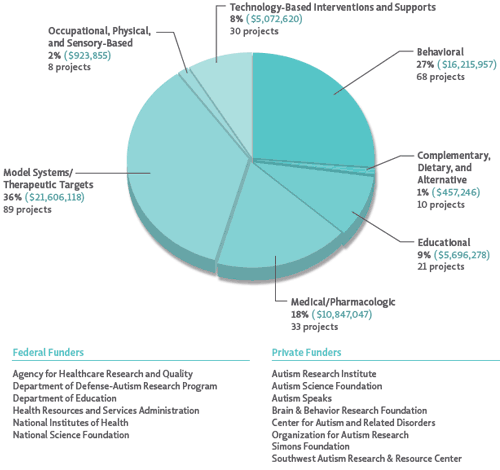
Figure 31. The subcategories for Question 4 (Treatments and Interventions) illustrate the many approaches to treatments and interventions supported by autism research funders. In 2011, the largest amount of funding supported projects to develop Model systems/Therapeutic targets (36%), followed by research on Behavioral interventions (27%). Medical/Pharmacologic interventions received 18% of funding, Educational (classroom-based) interventions received 9% of funding, and Technology-based interventions and supports received 8% of funding. The subcategories with the smallest amounts of funding included Occupational, physical, and sensory-based (2%) and Complementary, dietary, and alternative (1%). Please note that one project has been categorized as Other as it does not fall under one of the four main research areas of Question 4. However, this project, which evaluates the comparative effectiveness of multiple types of therapies for children with ASD, is not represented on the pie chart as although the project was active in 2011, there was no funding reported. The figure also lists Federal and private funders of research that fits within the Strategic Plan Question 4 category.
2012 Question 4: Treatments and Interventions – Funding by Subcategories
Total Funding: $64,149,900
Number of Projects: 270
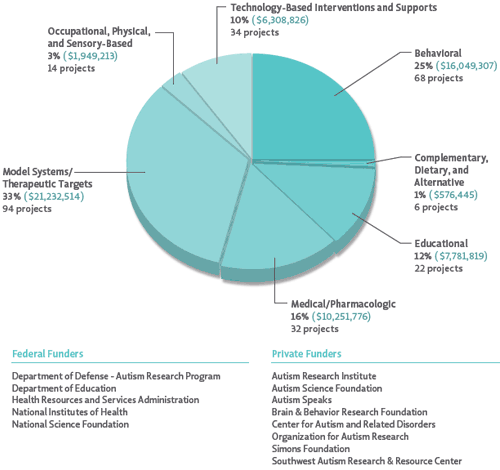
Figure 32. In 2012, the largest amount of funding for Question 4 (Treatments and Interventions) supported projects to develop Model systems/Therapeutic targets (33%). This was followed by research on Behavioral interventions (25%), Medical/Pharmacologic interventions (16%), Educational (classroom-based) interventions (12%), Technology-based interventions and supports (10%), Occupational, physical, and sensorybased interventions (3%), and finally Complementary, dietary, and alternative interventions (1%). The figure also lists Federal and private funders of research that fits within the Strategic Plan Question 4 category.
Progress Made on Question 4 from 2008-2012
Table 8 describes the progress made on the 12 research objectives within Question 4 over the five-year period from 2008-2012. The table also provides details regarding the status of funding for each objective, the status of research/scientific progress in each objective area, and information about remaining gaps, needs, and opportunities in each research area. Figure 33 shows the trend in Question 4 funding over time. Overall, Question 4 funding maintained a consistently high level. The progress made on the objectives to date suggests that while studies on areas that were prioritized before the Strategic Plan was in place, such as animal model development and randomized controlled trials of behavioral and pharmacological interventions, have received moderate to high funding to date, there are other areas of research that are still emerging. Examples include studies on interventions for high-risk children without a diagnosis (such as siblings of children with ASD) and studies of interventions for secondary health conditions.
Figure 33. Question 4 ASD Research Funding from 2008-2012. Funding for Question 4 remained steady, with a slight increase over the five-year span.
Question 4 Multiyear Funding Table
| IACC Strategic Plan Objectives | Funding | |||||
|---|---|---|---|---|---|---|
| Year | 2008 | 2009 | 2010 | 2011 | 2012 | Total |
IACC Strategic Plan ObjectivesSupport at least three randomized controlled trials that address co-occurring medical conditions associated with ASD by 2010. IACC Recommended Budget: $13,400,000 over 3 years |
Funding 20084.2 |
Funding 20094.S.A |
Funding 20104.S.A |
Funding 20114.S.A |
Funding 20124.S.A |
Funding Total$17,105,378 |
4.S.A. Funding: The recommended budget for this objective was met. Progress: More than three projects were funded, including trials of sleep, anxiety, seizure and gastrointestinal (GI) interventions, meeting the objective. Additional work will be needed in the future to fully address these conditions. Remaining Gaps, Needs, and Opportunities: Sleep issues, anxiety, hyperactivity and GI issues are key co-occurring medical conditions in patients with ASD. Although there is much more known today about sleep initiation than what was understood 5 years ago, there is little understanding of what interventions/treatments are effective for sleep maintenance or night awakening. There is not much known concerning anxiety treatments for those with ASD, and challenges exist regarding the adaptation of anxiety treatments from outside ASD patient groups. Research into interventions for hyperactivity may be transferred from populations outside of those with ASD (i.e., ADHD). Though there has been an increased awareness of gastrointestinal difficulties and common symptoms among people with ASD, little is known about the etiology of autism-related GI issues. More research on the etiology of GI issues will be needed to develop appropriate treatments/ interventions. |
||||||
| IACC Strategic Plan Objectives | Funding | |||||
| Year | 2008 | 2009 | 2010 | 2011 | 2012 | Total |
IACC Strategic Plan ObjectivesStandardize and validate at least 20 model systems (e.g., cellular and/or animal) that replicate features of ASD and will allow identification of specific molecular targets or neural circuits amenable to existing or new interventions by 2012. IACC Recommended Budget: $75,000,000 over 5 years |
Funding 20084.S.B |
Funding 20094.S.B |
Funding 20104.SB |
Funding 20114.S.B |
Funding 20124.S.B |
Funding Total$102,110,669 |
4.S.B. Funding: The recommended budget was met. Significantly more than the recommended minimum budget was allocated to projects specific to this objective. Progress: More than 90 projects were supported to develop animal models. Remaining Gaps, Needs, and Opportunities: Planning Group members discussed whether the amount of investment in this area is appropriate when compared to investments in clinical trials and other later stage studies. Invited experts suggested that the current stage of scientific research in ASD requires pre-clinical research to identify targets from animal and cellular models. Similar to cancer treatment development pathways, which spanned 20-30 years, research in ASD must invest in model systems to understand the fundamental biology from which translation to the clinic can be built. The translational validity of research in non-human animals cannot be determined until human trials are conducted, thus the need for rapid progress to clinical studies in humans is important. |
||||||
| IACC Strategic Plan Objectives | Funding | |||||
| Year | 2008 | 2009 | 2010 | 2011 | 2012 | Total |
IACC Strategic Plan ObjectivesTest safety and efficacy of at least five widely used interventions (e.g., nutrition, medications, assisted technologies, sensory integration, medical procedures) that have not been rigorously studied for use in ASD by 2012. IACC Recommended Budget: $27,800,000 over 5 years |
Funding 20084.6 |
Funding 20094.S.C |
Funding 20104.S.C |
Funding 20114.S.C |
Funding 20124.S.C |
Funding Total$8,946,921 |
4.S.C. Funding: The recommended budget was partially met. Progress: Several projects were funded in this area, but more work is needed, as this is an area of significant public interest. Remaining Gaps, Needs, and Opportunities: Experts discussed the best balance between developing new treatments and testing current treatments that lack evidence, especially when funds are limited and conclusive clinical trials are expensive. The group noted that interventions for minimally verbal children are needed; some projects on assistive communication technologies, robotics and speech processing technology to assist with social communication training are funded, but more are needed. There are other projects related to minimally verbal autism in objective 4.S.G. Small pilot studies on nutritional therapies (i.e., GFCF diet studies) have been conducted with inconclusive outcomes, demonstrating the necessity for further exploration of nutritional interventions. Future emphasis on scientific investment in sensory integration and assisted technologies is needed. |
||||||
| IACC Strategic Plan Objectives | Funding | |||||
| Year | 2008 | 2009 | 2010 | 2011 | 2012 | Total |
IACC Strategic Plan ObjectivesComplete two multi-site randomized controlled trials of comprehensive early intervention that address core symptoms, family functioning and community involvement by 2013. IACC Recommended Budget: $16,700,000 over 5 years |
Funding 20084.7 |
Funding 20094.S.D |
Funding 20104.S.D |
Funding 20114.S.D |
Funding 20124.S.D |
Funding Total$42,088,407 |
4.S.D. Funding: The recommended budget was met. Significantly more than the recommended minimum budget was allocated to projects specific to this objective. Progress: In 2011 and 2012, ˜20 trials were supported, including a mix of trial sizes. Remaining Gaps, Needs, and Opportunities: There is a need for both small, pilot studies and larger, robustly powered studies in this area. Several larger studies in the past few years (e.g., Early Start Denver Model) have emerged, but most studies in this area are generally smaller than in other fields of medicine and therefore lack the power to be informative if negative or definitive if positive. This objective also cites “family functioning” and “community living,” which may have significant overlap with objectives in Questions 5 and 6 of the Strategic Plan. |
||||||
| IACC Strategic Plan Objectives | Funding | |||||
| Year | 2008 | 2009 | 2010 | 2011 | 2012 | Total |
IACC Strategic Plan ObjectivesConvene a workshop to advance the understanding of clinical subtypes and treatment personalization (i.e., what are the core symptoms to target for treatment studies) by 2011. IACC Recommended Budget: $50,000 *This objective was partially completed in 2011 |
Funding 2008N/A |
Funding 20094.S.E |
Funding 20104.S.E |
Funding 20114.S.E* |
Funding 20124.S.E* |
Funding Total$26,000 |
4.S.E. Funding: The recommended budget was partially met, but was not put toward a single dedicated workshop. Progress: Two workshops and other activities that have partially addressed this issue have taken place, but to date there has not been a dedicated workshop on this issue, so this objective is marked “yellow.” Remaining Gaps, Needs, and Opportunities: Autism Speaks held two relevant workshops. The first, that took place on January 2011, “Outcome Measures for Clinical Trials with Individuals with ASD: Challenges and Opportunities,” was focused on developing strategies for advancing clinical trials of medications for ASD core and associated symptoms. The second, “Translational Medicine Research in ASD: Challenges and Opportunities,” that also took place in January 2011 focused on the basic science needed to discover and develop new treatments. Biomarkers and treatment personalization were among the topics discussed in both workshops. The EU-AIMS public-private consortium in Europe is working toward “developing and validating translational approaches for the advancement of novel therapies to treat ASD.” Identification of biomarkers of subtypes of ASD and personalization of interventions are within the consortium’s goals. Joint meetings between EU-AIMS and the Foundation for NIH Biomarkers Consortium, another recently-formed consortium around biomarkers and personalized treatments, are ongoing to determine the opportunities for collaboration on identifying surrogate markers for ASD treatment studies. Thus, while a dedicated workshop on clinical subtypes has not taken place, some of the present activities are discussing and implementing projects related to this topic. |
||||||
| IACC Strategic Plan Objectives | Funding | |||||
| Year | 2008 | 2009 | 2010 | 2011 | 2012 | Total |
IACC Strategic Plan ObjectivesLaunch randomized controlled trials of interventions including biological signatures and other measures to predict response, and monitor quality of life and functional outcomes in each of the following groups:
Total IACC Recommended Budget: $66,000,000 over 5 years |
Funding 20084.3 & 4.4 |
Funding 20094.S.F |
Funding 20104.S.F |
Funding 20114.S.F |
Funding 20124.S.F |
Funding Total$41,177,035 |
4.S.F. Funding: The recommended budget was partially met. Progress: The investment in projects under this objective is making good progress toward the recommended amount, with more than 20 projects funded in 2011 and 2012. Remaining Gaps, Needs, and Opportunities: Current projects in this area are restricted to small pilot studies, which are essential to establishing a foundation prior to expansion to larger scale work. Thus, increased investment in this area is important. It should be noted that most RCTs in the future will incorporate some aspect of biological signatures (thus potentially presenting a challenge to future coding of projects). |
||||||
| IACC Strategic Plan Objectives | Funding | |||||
| Year | 2008 | 2009 | 2010 | 2011 | 2012 | Total |
IACC Strategic Plan ObjectivesSupport at least five studies on interventions for nonverbal individuals with ASD by 2012. Such studies may include:
IACC Recommended Budget: $3,000,000 over 2 years |
Funding 2008N/A |
Funding 2009N/A |
Funding 20104.S.G |
Funding 20114.S.G |
Funding 20124.S.G |
Funding Total$9,730,403 |
4.S.G. Funding: The recommended budget was met. Significantly more than the recommended minimum budget was allocated to projects specific to this objective. Remaining Gaps, Needs, and Opportunities: The field of research on non-verbal patients with ASD is growing, yet still requires significant work and future investment. ASD research has historically concentrated on verbal individuals and adults, which highlights the need for increased research on minimally verbal populations. |
||||||
| IACC Strategic Plan Objectives | Funding | |||||
| Year | 2008 | 2009 | 2010 | 2011 | 2012 | Total |
IACC Strategic Plan ObjectivesSupport at least two studies that focus on research on health promotion and prevention of secondary conditions in people with ASD by 2012. Secondary conditions of interest include weight issues and obesity, injury, and co-occurring psychiatric and medical conditions. IACC Recommended Budget: $5,000,000 over 3 years |
Funding 2008N/A |
Funding 2009N/A |
Funding 20104.S.H |
Funding 20114.S.H |
Funding 20124.S.H |
Funding Total$1,404,969 |
4.S.H. Funding: The recommended budget was partially met. Progress: A small number of projects, but more than the recommended minimum, were funded, but further work is needed to address some of the specific issues described in the objective. Remaining Gaps, Needs, and Opportunities: Overlap in interpretation between “co-occurring” and “secondary” conditions presents a challenge in evaluating this objective. There is likely overlap between projects that may fit this objective and those in 4.S.A. Areas of health promotion and disease prevention should be emphasized in this objective, as those are distinct from issues mentioned in other objectives in this Question. It was noted that 4.S.H’s emphasis on prevention and health promotion may also overlap with 5.S.D and 5.L.D on “health and safety and mortality” issues. |
||||||
| IACC Strategic Plan Objectives | Funding | |||||
| Year | 2008 | 2009 | 2010 | 2011 | 2012 | Total |
IACC Strategic Plan ObjectivesComplete at least three randomized controlled trials on medications targeting core symptoms in people with ASD of all ages by 2014. IACC Recommended Budget: $22,200,000 over 5 years |
Funding 20084.8 |
Funding 20094.L.A |
Funding 20104.L.A |
Funding 20114.L.A |
Funding 20124.L.A |
Funding Total$9,715,095 |
4.L.A. Funding: The recommended budget was partially met. Progress: 10-14 studies have been funded, which is more than the minimum recommended, and momentum within the pre-clinical phases of this objective is currently building. It should be noted, however, in that many of these studies are small trials or pilot studies. Remaining Gaps, Needs, and Opportunities: Though there is little evidence that CNS drug development in animals will translate to humans, either in terms of toxicity or efficacy, there is still a need for investment in well-established animal model studies to identify promising molecular, cellular, or systems targets before mounting randomized clinical trials in humans. However, existing drugs for other indications may be adapted to ASD without extensive pre-clinical work, and there is also evidence for proof of concept studies for ASD (particularly those addressing core symptoms). It is also critically important to develop appropriate outcome measures for use in trials. |
||||||
| IACC Strategic Plan Objectives | Funding | |||||
| Year | 2008 | 2009 | 2010 | 2011 | 2012 | Total |
IACC Strategic Plan ObjectivesDevelop interventions for siblings of people with ASD with the goal of reducing the risk of recurrence by at least 30% by 2014. IACC Recommended Budget: $6,700,000 over 5 years |
Funding 20084.8 |
Funding 20094.L.B |
Funding 20104.LB |
Funding 20114.L.B |
Funding 20124.L.B |
Funding Total$831,111 |
4.L.B Funding: The recommended budget was not met; the funding allocated to projects specific to this objective falls far short of the recommendation. Progress: Only a small number of projects has been funded, and the intent of the objective has not been met to date. Research on siblings is still at an early stage, and the results, just beginning to be published, will inform future progress. Remaining Gaps, Needs, and Opportunities: Results from studies within this objective will emerge in the near future. Greater understanding of the mechanisms underlying sibling development of ASD will be key before any targeted early interventions may be developed for this population. |
||||||
| IACC Strategic Plan Objectives | Funding | |||||
| Year | 2008 | 2009 | 2010 | 2011 | 2012 | Total |
IACC Strategic Plan ObjectivesConduct at least one study to evaluate the safety and effectiveness of medications commonly used in the treatment of co-occurring conditions or specific behavioral issues in people with ASD by 2015. IACC Recommended Budget: $10,000,000 over 5 years |
Funding 2008N/A |
Funding 20094.L.C |
Funding 20104.L.C |
Funding 20114.L.C |
Funding 20124.L.C |
Funding Total$6,475,421 |
4.L.C Funding: The recommended budget was partially met. Progress: A small number (3-7) of studies of pharmacological interventions for co-occurring conditions was funded. There exist many studies examining drugs that are in active use for ADHD that are now being adapted to ADHD-ASD patient groups. Remaining Gaps, Needs, and Opportunities: There currently is much need for greater understanding of drug efficacy in ASD populations. |
||||||
| IACC Strategic Plan Objectives | Funding | |||||
| Year | 2008 | 2009 | 2010 | 2011 | 2012 | Total |
IACC Strategic Plan ObjectivesSupport at least five community-based studies that assess the effectiveness of interventions and services in broader community settings by 2015. Such studies may include comparative effectiveness research studies that assess the relative effectiveness of:
Outcome measures should include assessment of potential harm as a result of autism treatments, as well as positive outcomes. IACC Recommended Budget: $37,500,000 over 5 years |
Funding 2008N/A |
Funding 2009N/A |
Funding 20104.L.D. |
Funding 20114.L.D. |
Funding 20124.L.D. |
Funding Total$25,239,169 |
4.L.D. Funding: The recommended budget was partially met, and the annualized recommended budget targets were met for all 3 years since the objective was introduced. Therefore, the funding for this objective is on track. Progress: 30-45 studies have been supported, which is greater than the recommended minimum of at least five studies. Considerable work has been done under this objective, but these projects do not cover the full scope of interventions in the community. Comparing the large number of studies to the funding suggests that many small studies are being funded rather than fewer large ones. Remaining Gaps, Needs, and Opportunities: Emphasis on both the evaluation of interventions in controlled/academic settings prior to community based studies and the translation of interventions to community-based settings is key. Understanding of “Type 2 Translation,” or transfer of research from academic settings to real-world settings is important, considering barriers to transferring academic-based interventions to clinical groups and communities. Investment is still necessary in the academic setting before successful translation to community-based interventions can occur. For successful T2 translation to underserved communities, cost effectiveness and case coordination or case management is often helpful with uptake. This objective also overlaps considerably with objectives in Question 5. It is important to explore which supports are specifically executed at the community level (vs. home, schools, etc.), and to determine how they are best designed. |
||||||
| IACC Strategic Plan Objectives | Funding | |||||
| Year | 2008 | 2009 | 2010 | 2011 | 2012 | Total |
IACC Strategic Plan ObjectivesNot specific to any objective (Core/Other Activities) |
Funding 20084. Core/Other Activities |
Funding 20094. Core/Other Activities |
Funding 20104. Core/Other Activities |
Funding 20114. Core/Other Activities |
Funding 20124. Core/Other Activities |
Funding Total$44,566,554 |
IACC Strategic Plan Objectives†Total funding for Question 3† |
Funding 2008$53,968,973 |
Funding 2009$63,403,014 |
Funding 2010$68,123,890 |
Funding 2011$60,819,121 |
Funding 2012$64,149,900 |
Funding Total$310,464,898* |
Question 4 Multiyear Funding Table, see appendix for a color-coding key and further details.
*This total reflects all funding for projects aligned to current objectives in the 2011 IACC Strategic Plan and incorporates funding for projects that may have been coded differently in previous versions of the Plan.
†The totals reflect the funding and projects coded to this Question of the Strategic Plan in the particular year indicated at the top of the column. When reading each column vertically, please note that the projects and funding associated with each objective for 2008 may not add up to the total at the bottom of the column; this is due to revisions of the Strategic Plan that caused some objectives to be shifted to other Questions under the Plan. The projects and funding associated with these reclassified objectives are now reflected under the Question in which they appear in the 2011 Strategic Plan.
Table 8. Multiyear Funding Table for Question 4.7
7The numbers in this table have been updated since the 2013 IACC Strategic Plan has been published.
Question 5: Services
Aspirational Goal: Communities will access and implement necessary high-quality, evidence-based services and supports that maximize quality of life and health across the lifespan for all people with ASD
Research Focus of Question 5
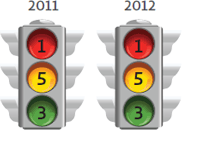 Question 5 ("Where can I turn for services?") focuses on services and supports for people with ASD. Objectives address issues including access to services for both individuals with ASD and their families, impact of self-directed care, coordination among State and local agencies’ community-based supports, and the assessment of the health, safety, and mortality of people with ASD. Question 5 also includes research to develop and evaluate the training of service providers (pediatricians, teachers, social workers, etc.), and improve the efficacy, cost-effectiveness, and dissemination of evidence-based practices.
Question 5 ("Where can I turn for services?") focuses on services and supports for people with ASD. Objectives address issues including access to services for both individuals with ASD and their families, impact of self-directed care, coordination among State and local agencies’ community-based supports, and the assessment of the health, safety, and mortality of people with ASD. Question 5 also includes research to develop and evaluate the training of service providers (pediatricians, teachers, social workers, etc.), and improve the efficacy, cost-effectiveness, and dissemination of evidence-based practices.
Analysis of Question 5 Portfolio 2011-2012
Question 5 accounted for 9% ($26.1 million) of the total ASD funding reported in 2011, and the percentage of all projects that fall under Question 5 was 11% (137 projects). In 2012, Question 5 accounted for 7% ($22.8 million) of the total ASD funding and 10% (138 projects) of the total number of projects included in the Portfolio Analysis.
Of the nine objectives in this question, progress was made on eight in both 2011 and 2012. In both years, three objectives reached or exceeded the recommended budget amount, some progress was made on five objectives, and only one objective showed no progress. A full list of objectives and details of their progress can be found in Table 9.
In 2011, 56% of funding was associated with projects assigned to a specific objective, whereas 44% of the funding was associated with projects designated as Core/Other (Figure 34). Similarly in 2012, 60% of the funding was associated with projects assigned to a specific objective, and 40% of the funding was associated with projects designated as Core/Other (Figure 34).
Following an increase in the reporting of funding attributed to projects in Question 5 in 2010 (the figure rose from $8.6 million in 2009 to $64.8 million in 2010), the funding reported in 2011 and 2012 has subsequently decreased. In 2010, the increase was mostly attributed to an addition of some large projects funded by the Health Resources and Services Administration (HRSA) to the data set, including their Leadership Education in Neurodevelopmental Disabilities (LEND) program, which supports fellowships to pediatricians to enhance the behavioral, psychosocial, and developmental aspects of general pediatric care, as well as their Developmental-Behavioral Pediatrics (DBP) Training Programs at multiple sites across the U.S. In addition, the Department of Education (ED) provided more comprehensive data for their autism-related portfolio in 2010, including projects which involved training teachers in effective methods to engage students with ASD and other developmental disabilities. In 2011 and 2012, an adjustment was made in reporting budget figures for certain large services projects to account for the fact that some of those projects were only partially focused on autism or only partially focused on research. Funding was prorated to only reflect the ASD-specific portion or the portion related to research. In addition to this adjustment, another contributor to the apparent decrease in funding in 2011 and 2012 was that some projects that had received all of their funding in the first year reported $0 in 2011 and 2012, though the projects were still active. These factors together contributed to what appears to be a significant decrease in funding reported for Question 5 in 2011-2012, though if similar adjustments were made to the 2010 data, the change from 2010 to 2011 would be less significant (Figure 37).
The two objectives receiving the most funding in 2011 and 2012 were 5.L.A and 5.L.C, both of which achieved green light (completed) status. Objective 5.L.A, which supports projects to improve dissemination, implementation, and sustainability of evidenced-based interventions, received 22% ($5.8 million) of the Question 5 funding in 2011, and 32% ($7.2 million) in 2012. Evaluation of new and existing training of service providers (5.L.C) accounted for 23% ($6.0 million) and 16% ($3.7 million) of Question 5 funding in 2011 and 2012 respectively. A significant portion of the projects included in this objective are LEND grants that were prorated, therefore this objective has seen a significant drop in funding from 2010 levels ($36.4 million). Assessment of how access to services affects family functioning in diverse populations (5.S.A) was the third most highly funded Question 5 objective in 2011 and 2012 (assigned a green light both years), accounting for 5% ($1.4 million) and 6% ($1.4 million) of funding in 2011 and 2012 respectively. Objective 5.S.C, which calls for implementation and evaluation of coordination among State and local agencies to provide integrated and comprehensive community-based supports and services for individuals with ASD saw a significant decrease in reported funding from $4.2 million in 2010, to $0.6 million (2.6%) in both 2011 and 2012. The progress on this objective in 2010 was attributed to HRSA’s State ASD Demonstration projects, which were not included in the projects that HRSA reported for the 2011-2012 Portfolio Analysis because they were determined not to be research projects, though their goals are related to implementation and evaluation of models of policy and practice-level coordination among state and local agencies. All other objectives each accounted for 2% or less of the overall funding reported for Question 5 in 2011 and 2012. However, Objective 5.L.B, which calls for testing the efficacy and cost-effectiveness of evidence-based services and supports for people with ASD in community settings, did not have any active projects in 2011 (red light), but now has one active project (yellow light) in 2012, with $0.5 million in funding.
Examples of Topics addressed by Projects in Core/Other:
- Research on social networks and collaborations involving parents and heath care and service providers
- Research on family well-being support services
- Projects to develop and evaluate practitioner training programs and special educator preparation
- Research on transition in the early school years for children with autism
Figure 34. More than half of the ASD research projects in Question 5 were coded to specific objectives; projects that did not fit within the IACC Strategic Plan objectives were coded as Core/Other. Examples of topics addressed by projects in Core/Other are listed above.
Question 5 Subcategory Analysis
Projects within Question 5, which accounted for approximately $26.1 million in 2011 and $22.8 million in 2012, have been categorized into five subcategories which reflect the general scope of research on services and supports: Community inclusion programs; Efficacious and cost-effective service delivery; Family well-being and safety; Practitioner training; and Services utilization and access (Figures 35 and 36).
As in 2010, the largest subcategory continued to be Practitioner training research, receiving 74% and 66% of Question 5 funding in 2011 and 2012 respectively. Efficacious and cost-effective service delivery, which covers research projects ranging from those to assess current service delivery models to those focused on developing new and efficient ways of providing services such as web-based approaches, received 10% of the funding in 2011 and 16% in 2012. This was followed by research on Services utilization and access (including disparities and potential barriers to access), which often encompasses survey-based research and accounted for 10% and 12% of the funding in Question 5 in 2011 and 2012 respectively. Family well-being and safety research projects received 5% and 4% of the funding, and research on Community inclusion programs received 1% and 2% in 2011 and 2012 funding respectively. Figures 35 and 36 also list Federal and private funders of research that fits within the Strategic Plan Question 5 category.
2012 Question 5: Services – Funding by Subcategories
Total Funding: $26,118,904
Number of Projects: 137
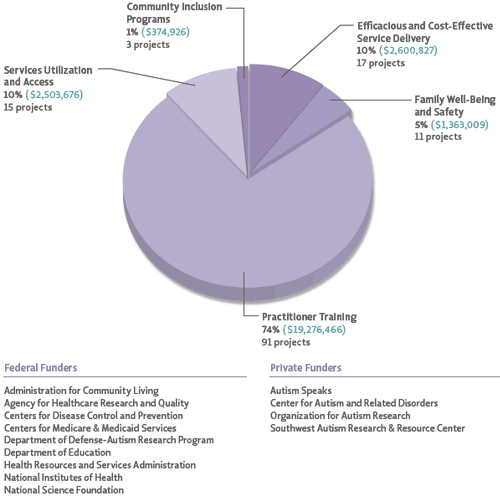
Figure 35. Projects aligning with Question 5 (Services) were divided across five subcategories. In 2011, subcategory on Practitioner training research accounted for 74% of the funding for this question. Research projects related to Services utilization and access followed with 10% of the funding, and Efficacious and cost effective service delivery accounted for 10%. Only 5% of funding was designated for research projects related to Family well-being and safety, and 1% supported Community inclusion programs. The figure also lists Federal and private funders of research that fits within the Strategic Plan Question 5 category.
2012 Question 5: Services – Funding by Subcategories
Total Funding: $22,827,101
Number of Projects: 138
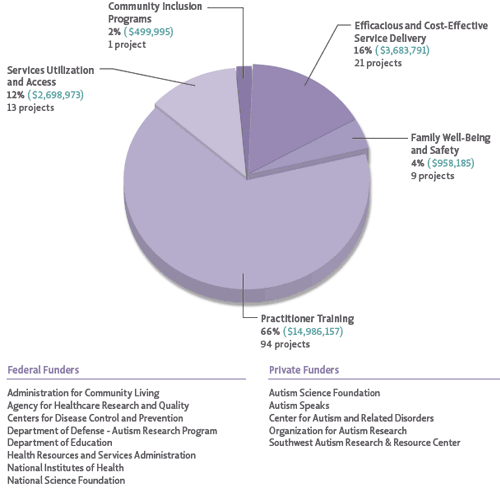
Figure 36. In 2012, the research on Practitioner training subcategory accounted for two thirds (66%) of the funding for Question 5 (Services). Projects related to research on Efficacious and cost-effective service delivery followed with 16% of the funding, and Services utilization and access accounted for 12%. Family well-being and safety projects received 4% of funding, and projects relating to Community inclusion programs received 2%. The figure also lists Federal and private funders of research that fits within the Strategic Plan Question 5 category.
Progress Made on Question 5 from 2008-2012
Table 9 describes the progress made on the nine research objectives within Question 5 over the five-year period from 2008-2012. The table also provides details regarding the status of funding for each objective, the status of research/scientific progress in each objective area, and information about remaining gaps, needs, and opportunities in each research area. Figure 37 shows the trend in Question 5 funding over time. Research related to Question 5 was funded at relatively low levels in comparison with other areas. Question 5 saw a substantial increase in funding from 2008 to 2010, but after adjustments were made in reporting to only report autismspecific and research-related portions of larger projects, funding appeared to decrease from 2010-2012. In addition, an estimated line for Question 5 funding in 2010 is included in the graph to enable a more accurate comparison among years. To calculate the estimated line for 2010, the same methodology for the prorated rates in 2011 and 2012 was used. When these adjustments are made to the 2010 data set, the change from 2009 to 2010, and 2010 to 2011, appear to be less significant. Overall, when comparing 2008 funding for Question 5 with 2012 funding, the general trend is upward, though Question 5 also gained several new objectives from 2008-2011; this also contributed to the rise.
Among the nine Question 5 objectives, considerable progress was made in each objective. Approximately 60% of the total funding for Question 5 was related to specific objectives, while 40% were in areas covered by the Core/ Other category, which may represent areas of ongoing, mainstream efforts or emerging research areas that have not been captured in the IACC Strategic Plan objectives.
Figure 37. Question 5 ASD Research Funding from 2008-2012. Overall, funding for Question 5 was lower than some other areas of the Strategic Plan, but it increased over the five-year span. An estimated line for 2010 was included to depict the same methodology for prorated rates made in 2011 and 2012.
Question 5 Multiyear Funding Table
| IACC Strategic Plan Objectives | Funding | |||||
|---|---|---|---|---|---|---|
| Year | 2008 | 2009 | 2010 | 2011 | 2012 | Total |
IACC Strategic Plan ObjectivesSupport two studies that assess how variations in and access to services affect family functioning in diverse populations, including underserved populations, by 2012. IACC Recommended Budget: $1,000,000 over 3 years |
Funding 20085.2 |
Funding 20095.S.A |
Funding 20105.S.A |
Funding 20115.S.A |
Funding 20125.S.A |
Funding Total$5,277,713 |
5.S.A. Funding: The recommended budget was met. Significantly more than the recommended minimum budget was allocated to projects specific to this objective. Progress: The initial target of two studies was met, with 1-9 projects supported per year, but more work is still needed in this area. Remaining Gaps, Needs, and Opportunities: The projects under this objective cover several topics related to family functioning and health disparities, but not the full breadth of the gaps mentioned in the objective. This objective, as written, may be too broad. Work is still needed to understand why underserved populations have poorer outcomes and what can be done to close the gaps. We need to understand what portfolio of services will result in the best outcomes for different populations. To address these questions, a qualitative approach (i.e., needs assessment or survey) may be needed to understand the context of barriers faced by different groups. Research on disparities needs to move beyond observational studies to experimental designs to see what approaches work best in different populations and settings. |
||||||
| IACC Strategic Plan Objectives | Funding | |||||
| Year | 2008 | 2009 | 2010 | 2011 | 2012 | Total |
IACC Strategic Plan ObjectivesConduct one study to examine how self-directed community-based services and supports impact children, youth, and adults with ASD across the spectrum by 2014. IACC Recommended Budget: $6,000,000 over 3 years |
Funding 2008N/A |
Funding 20095.S.B |
Funding 20105.SB |
Funding 20115.S.B |
Funding 20125.S.B |
Funding Total$737,975 |
5.S.B. Funding: The recommended budget was partially met. Progress: More work is needed in this area to achieve the goals set forth by the objective. While more than the number of studies called for have been supported, the area is underfunded (the projects have been small) and the projects do not examine all areas targeted in the objective. Remaining Gaps, Needs, and Opportunities: Several of the funded projects relate to recreational activities, but more projects that focus on issues such as housing, employment, and quality of life (self-direction) are needed. Issues such as housing and employment may not be reflected in the portfolio data because the agencies and organizations included in the analysis may not have these topics as a primary focus, and many housing and employment-related efforts may not be specific to ASD. This area may benefit from a “practice to research” approach where already-operating programs can be evaluated for efficacy and this may help to develop more easily implementable services. Work is also needed to determine what outcome measures are informative and useful. Another issue is the scalability, as many vocational projects are very small and intensive and this is not an effective model for broad implementation. Potential funding mechanisms for these evaluations include the Dept. of Education Institute of Educational Science program for partnering researchers and educators and the NIMH Research Initiative for Scientific Enhancement (RISE) R25 program. |
||||||
| IACC Strategic Plan Objectives | Funding | |||||
| Year | 2008 | 2009 | 2010 | 2011 | 2012 | Total |
IACC Strategic Plan ObjectivesImplement and evaluate five models of policy and practice-level coordination among State and local agencies to provide integrated and comprehensive community-based supports and services that enhance access to services and supports, self-determination, economic self-sufficiency, and quality of life for people with ASD across the spectrum and their families, (which may include access to augmentative and alternative communication [AAC] technology), with at least one project aimed at the needs of transitioning youth and at least one study to evaluate a model of policy and practice-level coordination among State and local mental health agencies serving people with ASD, by 2015. IACC Recommended Budget: $25,000,000 over 5 years (revised in 2011) |
Funding 2008N/A |
Funding 20095.S.C |
Funding 20105.S.C |
Funding 20115.S.C |
Funding 20125.S.C |
Funding Total$5,425,315 |
5.S.C. Funding: The recommended budget was partially met. Progress: Progress has been made but the objective is not fully achieved, as it is underfunded and the projects do not cover all of the issues mentioned in the objective. Remaining Gaps, Needs, and Opportunities: Studying services coordination is very difficult and it is hard to define outcomes. State to state dissemination is very limited and fragmented. Also, state policies often are translated to practice very differently in different areas and counties. State and local services programs also suffer from a lack of knowledge in how to engage and sustain community partnerships. A pairing of existing state and local services programs (including those that may be participating in federally-funded state demonstration programs) with research funding for evaluation would be the most cost-effective way to collect and analyze data about the implementation of models of coordination. For example, building research projects onto existing state demonstration programs and supporting the development of partnerships between academic researchers and state agencies to study models of policy implementation would be ways to advance this type of research. |
||||||
| IACC Strategic Plan Objectives | Funding | |||||
| Year | 2008 | 2009 | 2010 | 2011 | 2012 | Total |
IACC Strategic Plan ObjectivesSupport two studies to examine health, safety, and mortality issues for people with ASD by 2012. IACC Recommended Budget: $4,500,000 over 3 years |
Funding 2008N/A |
Funding 2009N/A |
Funding 20105.S.D |
Funding 20115.S.D |
Funding 20125.S.D |
Funding Total$164,135 |
5.S.D. Funding: The recommended budget was not met; the funding allocated to projects specific to this objective falls far short of the recommendation. Progress: More work is needed on this objective; studies have been funded in this area (e.g., wandering, victimization), but they are small and they do not address all issues within this objective. Remaining Gaps, Needs, and Opportunities: There may be some projects in other Strategic Plan Questions that are related to this objective (i.e., the Utah epidemiological study coded to Question 7 that examines health risks and causes of mortality). There is ongoing data mining of existing data sets to identify risks, new methods of prevention, methods of recovery, and best practices. Best practices need to be developed to respond to wandering (prevention, response, and search). A “practice to research” model, where data are collected in the process of delivering services, would also be appropriate. One issue that is underrepresented in the portfolio is sexual/reproductive health communication for adolescents and adults with ASD. In general, adult needs are not well-represented in the current research. |
||||||
| IACC Strategic Plan Objectives | Funding | |||||
| Year | 2008 | 2009 | 2010 | 2011 | 2012 | Total |
IACC Strategic Plan ObjectivesTest four methods to improve dissemination, implementation, and sustainability of evidence-based interventions, services, and supports in diverse community settings by 2013. IACC Recommended Budget: $50,000 IACC Recommended Budget: $7,000,000 over 5 years |
Funding 20085.4 |
Funding 20095.L.A |
Funding 20105.L.A |
Funding 20115.L.A |
Funding 20125.L.A |
Funding Total$28,857,050 |
5.L.A. Funding: The recommended budget was met. Significantly more than the recommended minimum budget was allocated to projects specific to this objective. Progress: This is a very broad objective, and a lot of research is being supported in this area. More work is needed, however, to cover the range of topics addressed in the objective. Remaining Gaps, Needs, and Opportunities: Specifically, the requirement of projects looking at diverse community settings has not been met. Most of the projects listed are not focused on dissemination or may be using a model that is not well-translated to autism. Dissemination should be part of a grant application and this should be rigorously enforced. An opportunity in this area would be to create and support training institutes within existing networks that are focused on implementation and dissemination. |
||||||
| IACC Strategic Plan Objectives | Funding | |||||
| Year | 2008 | 2009 | 2010 | 2011 | 2012 | Total |
IACC Strategic Plan ObjectivesTest the efficacy and cost-effectiveness of at least four evidence-based services and supports for people with ASD across the spectrum and of all ages living in community settings by 2015. IACC Recommended Budget: $16,700,000 over 5 years |
Funding 20085.3 |
Funding 20095.L.B |
Funding 20105.L.B |
Funding 20115.L.B |
Funding 20125.L.B |
Funding Total$603,717 |
5.L.B. Funding: The recommended budget was not met; the funding allocated to projects specific to this objective falls far short of the recommendation. Progress: There are ongoing projects under this objective with regard to efficacy but not cost-effectiveness. More work is needed and in general, the intention of this objective has not been achieved. Remaining Gaps, Needs, and Opportunities: Cost-effectiveness evaluations have to be paired with randomized controlled trials (RCTs). Efforts should be made to build onto existing efforts by adding cost-effectiveness evaluation to existing RCTs. Administrative supplements may help to achieve those additions. There are not well established autism-specific measures of cost-effectiveness. Some barriers to achieving this objective include the need for a long follow up period, which often is not possible due to the cost of running longer term trials. Also, these projects often do not receive favorable scores during grant review because review favors tightly controlled experimental designs rather than experimentation in real-world conditions. |
||||||
| IACC Strategic Plan Objectives | Funding | |||||
| Year | 2008 | 2009 | 2010 | 2011 | 2012 | Total |
IACC Strategic Plan ObjectivesEvaluate new and existing pre-service and in-service training to increase skill levels in service providers, including direct support workers, parents and legal guardians, education staff, and public service workers, to benefit the spectrum of people with ASD and to promote interdisciplinary practice by 2015. IACC Recommended Budget: $8,000,000 over 5 years |
Funding 20086.3 |
Funding 20095.L.C |
Funding 20105.L.C |
Funding 20115.L.C |
Funding 20125.L.C |
Funding Total$46,368,747 |
5.L.C. Funding: The recommended budget was met. Significantly more than the recommendedminimum budget was allocated to projects specific to this objective. Progress: Many projects have been funded in this area. However, there is an ongoing need for support of efforts in this area. Remaining Gaps, Needs, and Opportunities: Significant workforce needs remain, especially with regard to paraprofessionals. With all studies in this objective, there remains an issue of scale. Most training programs are designed for small groups. In order for training to be effective at the community level, it has to be able to scale up for broad dissemination, so training programs need to be evaluated for their potential to be scaled up. Comparative effectiveness studies of training models are needed to illuminate whether or not providers need more training, which populations require which training methods, and which training methods are most effective. |
||||||
| IACC Strategic Plan Objectives | Funding | |||||
| Year | 2008 | 2009 | 2010 | 2011 | 2012 | Total |
IACC Strategic Plan ObjectivesEvaluate at least two strategies or programs to increase the health and safety of people with ASD that simultaneously consider principles of selfdetermination and personal autonomy by 2015. IACC Recommended Budget: $2,000,000 over 2 years |
Funding 2008N/A |
Funding 2009N/A |
Funding 20105.L.D |
Funding 20115.L.D |
Funding 20125.L.D |
Funding Total$631,838 |
5.L.D. Funding: The recommended budget was small yet was partially met. Progress: Though more than the two studies recommended as a minimum have been funded in this area, more work is needed. This objective overlaps significantly with 5.S.D and also with 4.S.H. In the future, perhaps these objectives should be collapsed and combined. Remaining Gaps, Needs, and Opportunities: Obesity is an important issue related to this objective that is currently not represented to a great extent in the portfolio. It is therefore an area where, moving forward, there should be more focus. |
||||||
| IACC Strategic Plan Objectives | Funding | |||||
| Year | 2008 | 2009 | 2010 | 2011 | 2012 | Total |
IACC Strategic Plan ObjectivesSupport three studies of dental health issues for people with ASD by 2015. This should include:
IACC Recommended Budget: $900,000 over 3 years for each sub-objective ($2,700,000 total) |
Funding 2008N/A |
Funding 2009N/A |
Funding 20105.L.E |
Funding 20115.L.E |
Funding 20125.L.E |
Funding Total$9,48,101 |
5.L.E. Funding: The recommended budget was partially met. Progress: While several important projects have been funded in this area, there is a gap in projects that focus on dental services for adults and training for dentists working with autistic adults. Remaining Gaps, Needs, and Opportunities: While the funded studies focus on behavior management, a more comprehensive health focus is needed to address the dental needs of children and adults with ASD. This objective is very specific, but there are other important primary health care needs for people with ASD that need to be addressed. In the future, perhaps this topic could be collapsed under a broader general objective that addresses primary health care needs (combined with 5.S.D, 5.L.D). If a new objective were to be written, other important primary care issues such as mental health services should be included. |
||||||
| IACC Strategic Plan Objectives | Funding | |||||
| Year | 2008 | 2009 | 2010 | 2011 | 2012 | Total |
IACC Strategic Plan ObjectivesNot specific to any objective (Core/Other Activities) |
Funding 20085. Core/Other Activities |
Funding 20095. Core/Other Activities |
Funding 20105. Core/Other Activities |
Funding 20115. Core/Other Activities |
Funding 20125. Core/Other Activities |
Funding Total$37,303,139 |
IACC Strategic Plan Objectives†Reported funding for Question 5* |
Funding 2008$1,685,222 |
Funding 2009$8,648,050 |
Funding 2010$64,849,122 |
Funding 2011$26,118,904 |
Funding 2012$22,827,101 |
Funding Total$124,128,399 |
IACC Strategic Plan Objectives†Adjusted funding for Question 5† |
Funding 2008$3,874,552 |
Funding 2009$8,648,050 |
Funding 2010$64,849,122 |
Funding 2011$26,118,904 |
Funding 2012$22,827,101 |
Funding Total$126,317,730 |
Question 5 Multiyear Funding Table, see appendix for a color-coding key and further details.
*The “Reported funding” totals reflect the funding and projects originally coded to this Question of the Strategic Plan, as reported in the Portfolio Analysis Report corresponding to the year indicated at the top of the column. When reading each column of the table vertically, please note that the projects and funding associated with each objective for the years 2008 and 2009 may not add up to the reported funding total at the bottom of the column; this is due to adjustments made to account for revisions in the Strategic Plan, which caused the shifting of some objectives to other Questions under the Plan. The projects and funding associated with these reclassified objectives are now reflected under the Question in which they appear in the 2011 Strategic Plan.
†The “Adjusted funding” total reflects funding for projects aligned to objectives in the 2011 IACC Strategic Plan (the most recent version in which objectives were revised) and incorporates funding for projects that may have been coded differently under previous versions of the Plan.
Table 9. Multiyear Funding Table for Question 5.
Question 6: Lifespan Issues
Aspirational Goal: All people with ASD will have the opportunity to lead self-determined lives in the community of their choice through school, work, community participation, meaningful relationships, and access to necessary and individualized services and supports.
Research Focus of Question 6
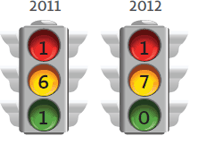 With increasing societal awareness of the needs of people on the autism spectrum across the lifespan, Question 6 addresses the question “What does the future hold, particularly for adults?” Question 6 encompasses research to identify and address issues surrounding transition to adulthood, access to services across the lifespan, and quality of life. Some of the research in Question 6 represents projects that assess the longterm outcomes (in terms of measures such as quality of life, health, independence, and employment) for people on the autism spectrum, particularly with respect to interventions and services they might have received. Many projects assigned to Question 6 focus on adolescents transitioning from the education system to employment, as
well as vocational/job skills and social skills training for both transitional aged youth and adults.
With increasing societal awareness of the needs of people on the autism spectrum across the lifespan, Question 6 addresses the question “What does the future hold, particularly for adults?” Question 6 encompasses research to identify and address issues surrounding transition to adulthood, access to services across the lifespan, and quality of life. Some of the research in Question 6 represents projects that assess the longterm outcomes (in terms of measures such as quality of life, health, independence, and employment) for people on the autism spectrum, particularly with respect to interventions and services they might have received. Many projects assigned to Question 6 focus on adolescents transitioning from the education system to employment, as
well as vocational/job skills and social skills training for both transitional aged youth and adults.
Analysis of Question 6 Portfolio 2011-2012
Funding allocated to projects on lifespan issues addressed by Question 6 represented the smallest segment of ASD research funding. In 2011 and 2012, projects in Question 6 received 2% ($4.9 million) and 1% ($3.9 million) of overall ASD funding respectively, similar to the investment made in 2010 (2%, $6.6 million). When considering number of projects, Question 6 made up only 3% of the whole ASD portfolio, with 35 projects in 2011 and 34 projects in 2012. However, it is important to note that some projects that address lifespan issues, such as transition programs aimed at adolescents and their families as well as evaluation of practitioner training focused on transition-age youth, were better captured by objectives in other questions, and thus were not categorized into Question 6.
In 2011, progress was made in seven of the eight Question 6 objectives. In 2012, seven objectives had active projects, but overall, most of the objectives in Question 6 were far below recommended funding levels. A full list of objectives and their progress can be found in Table 10.
The majority of the projects assigned to Question 6 fit into the Question 6 objectives. In 2011, 1% ($50,000) of the funding went to projects designated as Core/Other, and in 2012, 22% ($0.8 million) of the funding went to projects designated as Core/Other (Figure 38).
Projects focused on developing community-based interventions for adults (6.L.A) received the largest portion of Question 6 funding in 2011 (44%, $2.2 million). This was followed by Objective 6.L.B, which calls for research to determine how interventions, services, and supports delivered during childhood impact adult health and quality of life outcomes; this objective received $1.3 million (28%) in 2011, meeting the annualized budget target, but only had $0.6 million in funding in 2012, and fell short of the overall recommended budget (yellow light). Research to evaluate existing programs for youth transitioning to adulthood (6.S.B) accounts for 14% ($0.7 million) in 2011, and studies assessing the quality of life of adults as it relates to characteristics of the service delivery system (6.S.A) accounted for 11% ($0.5 million) in 2011. The same four objectives continued to receive the most funding in 2012, and were as follows: 6.S.A (26%, $1.0 million), 6.S.B (18%, $0.7 million), 6.L.B (17%, $0.6 million), and 6.L.A (16%, $0.6 million). The remaining three objectives with active projects received 2% or less of the 2011 and 2012 Question 6 funding.
In 2011 and 2012, only one objective lacked any active projects. This objective (6.L.C) calls for comparative effectiveness research (which includes a cost-effectiveness component) into how community-based interventions, services, and supports improve health outcomes and quality of life for adults. Although there were two projects in this objective in 2010, leading to a yellow light for total funding, comparative effectiveness research in the area of lifespan issues remains quite limited and underfunded.
Examples of Topics addressed by Projects in Core/Other:
- Studies of social and occupational status, as well as other indicators in the population of adults with ASD
- Comparative effectiveness of interventions for adolescents and young adults
- Research and evaluation of housing needs for adults with ASD
- Evaluation of the experiences and needs of adults with ASD for various types of services
- Transition and support programs to help students with ASD graduate and achieve career goal
Figure 38. Most ASD research projects in Question 6 were coded to specific objectives; those that did not fit within the IACC Strategic Plan objectives were coded as Core/Other. Examples of topics addressed by projects in Core/Other are listed above.
Question 6 Subcategory Analysis
Because Question 6 had so few assigned projects (35 projects in 2011 and 34 projects in 2012) and only $3.9 million of total ASD funding in 2012, and many projects encompassed more than one topic for example, one project explores the role of self-determination, social skills, job search strategies, use of transportation, and rehabilitation services on employment outcomes among transition-age youth, it was difficult to formulate and group the research into subcategories in the same fashion as was done for other questions. However, this will likely change as the research field concerned with ASD across the lifespan grows and matures, allowing the development of subcategories in the future.
Progress Made on Question 6 from 2008-2012
Table 10 describes the progress made on the eight research objectives within Question 6 over the five-year period from 2008-2012. The table also provides details regarding the status of funding for each objective, the status of research/scientific progress in each objective area, and information about remaining gaps, needs, and opportunities in each research area. Figure 39 shows the trend in Question 6 funding over time. Question 6 has received the smallest proportion of overall autism research funding from 2009-2012, in line with the very small number of projects assigned to this question. From 2009 to 2010, there was a small increase in funding, but from 2010 to 2012, funding generally leveled off at a low level. However, several of the objectives in Question 6 overlap with objectives from other questions which may have resulted in projects being assigned to other questions in the Strategic Plan; this may have contributed to this relatively low funding level.
Although total funding for Question 6 is low, all eight objectives have seen progress over the five-year span, though for some, the investment has been very low. Overall, many of the research needs related to adults on the autism spectrum and lifespan issues remain unmet, and more focus on this area is warranted.
Figure 39. Question 6 ASD Research Funding from 2008-2012. Funding for Question 6 stayed relatively low over the five-year span.
Question 6 Multiyear Funding Table
| IACC Strategic Plan Objectives | Funding | |||||
|---|---|---|---|---|---|---|
| Year | 2008 | 2009 | 2010 | 2011 | 2012 | Total |
IACC Strategic Plan ObjectivesLaunch at least two studies to assess and characterize variation in the quality of life for adults on the ASD spectrum as it relates to characteristics of the service delivery system (e.g., safety, integrated employment, postsecondary educational opportunities, community inclusion, self-determination, relationships, and access to health services and community-based services) and determine best practices by 2012. IACC Recommended Budget: $5,000,000 over 3 years |
Funding 20086.2 |
Funding 20096.S.A |
Funding 20106.S.A |
Funding 20116.S.A |
Funding 20126.S.A |
Funding Total$1,919,186 |
6.S.A. Funding: The recommended budget was partially met. Progress: More than (the recommended minimum of) two projects have been funded in this area, though the end goal of determining best practices has not yet been met. Still, this area is moving in the right direction as funding and projects have increased over time. Remaining Gaps, Needs, and Opportunities: There is a great need to develop standardized measures for quality of life for people with ASD, across both range of ability and lifespan. |
||||||
| IACC Strategic Plan Objectives | Funding | |||||
| Year | 2008 | 2009 | 2010 | 2011 | 2012 | Total |
IACC Strategic Plan ObjectivesEvaluate at least one model, at the State and local level, in which existing programs to assist people with disabilities (e.g., Social Security Administration, Rehabilitation Services Administration) meet the needs of transitioning youth and adults with ASD by 2013. IACC Recommended Budget: $5,000,000 over 3 years |
Funding 2008N/A |
Funding 20096.S.B |
Funding 20106.SB |
Funding 20116.S.B |
Funding 20126.S.B |
Funding Total$2,100,000 |
6.S.B. Funding: The recommended budget was partially met. Progress: More than (the recommended minimum of) one project was funded, meeting the initial target of this objective. Remaining Gaps, Needs, and Opportunities: Current projects relate to vocational rehabilitation, as called for in the objective, but no projects address Social Security programs, which remain a need. Also, looking at one model is too limited in scope, and stronger partnerships among programs would be beneficial for this objective. In the future, perhaps this objective could be expanded to include more projects and/or funding to examine other models. |
||||||
| IACC Strategic Plan Objectives | Funding | |||||
| Year | 2008 | 2009 | 2010 | 2011 | 2012 | Total |
IACC Strategic Plan ObjectivesDevelop one method to identify adults across the ASD spectrum who may not be diagnosed, or are misdiagnosed, to support service linkage, better understand prevalence, and track outcomes with consideration of ethical issues (insurance, employment, stigma) by 2015. IACC Recommended Budget: $8,400,000 over 5 years |
Funding 2008N/A |
Funding 20096.S.C |
Funding 20106.S.C |
Funding 20116.S.C |
Funding 20126.S.C |
Funding Total$56,000 |
6.S.C. Funding: The recommended budget was not met; the funding allocated to projects specific to this objective falls far short of the recommendation. Progress: The objective called for a minimum of one project, and one small project to adapt the ADOS modules 1 and 2 for use in adults has been supported in this area, but most likely multiple projects testing various approaches, followed by intense efforts to refine the instruments, would be needed to develop a set of tools that could be used in different settings to diagnose adults. Remaining Gaps, Needs, and Opportunities: In addition to developing tools that can be used for screening and diagnosis in adults, it is critical to ensure that diagnosis links to a plan for intervention and /or service provision for diagnosed adults, resulting in improved outcomes. |
||||||
| IACC Strategic Plan Objectives | Funding | |||||
| Year | 2008 | 2009 | 2010 | 2011 | 2012 | Total |
IACC Strategic Plan ObjectivesConduct at least one study to measure and improve the quality of lifelong supports being delivered in community settings to adults across the spectrum with ASD through provision of specialized training for direct care staff, parents, and legal guardians, including assessment and development of ASD-specific training, if necessary, by 2015. IACC Recommended Budget: $7,500,000 over 3 years |
Funding 2008N/A |
Funding 20096.S.D |
Funding 20106.S.D |
Funding 20116.S.D |
Funding 20126.S.D |
Funding Total$619,163 |
6.S.D. Funding: The recommended budget was not met; the funding allocated to projects specific to this objective falls far short of the recommendation. Progress: While more than one project has been funded, and the objective called for one project at minimum, the current funding and projects for this objective are not likely to meet the intent of the objective. Also, the few projects funded do not address the full range of issues mentioned in this objective. Remaining Gaps, Needs, and Opportunities: The projects under this objective focus on secondary students and transition age youth and there are no projects focusing on older adults. No new projects were funded in 2011 and 2012, though the goals of this objective are similar/overlapping to those of 5.L.C, and projects coded there may also represent progress on this objective. There is a need for effective training for healthcare staff and guardians that can be delivered cost-effectively on a large scale. |
||||||
| IACC Strategic Plan Objectives | Funding | |||||
| Year | 2008 | 2009 | 2010 | 2011 | 2012 | Total |
IACC Strategic Plan ObjectivesDevelop at least two individualized communitybased interventions that improve quality-of-life or health outcomes for the spectrum of adults with ASD by 2015. IACC Recommended Budget: $12,900,000 over 5 years |
Funding 20086.5 |
Funding 20096.L.A |
Funding 20106.L.A |
Funding 20116.L.A |
Funding 20126.L.A |
Funding Total$5,565,325 |
6.L.A. Funding: The recommended budget was partially met. Progress: Between 11 and 18 projects were supported each year between 2010 and 2012. Progress is being made; however, a sustained effort is needed to fully achieve the goals set forth by this objective. Funding for projects specific to this objective was substantially lower in 2012 than previous years, which is a concern. Remaining Gaps, Needs, and Opportunities: Work focused on adults with ASD lags behind that focused on children and adolescents. This objective is similar to 6.S.A – it might be helpful to separate the outcomes of interest to better assess progress. Also, quality of life outcome measures are needed to know if interventions are working. |
||||||
| IACC Strategic Plan Objectives | Funding | |||||
| Year | 2008 | 2009 | 2010 | 2011 | 2012 | Total |
IACC Strategic Plan ObjectivesConduct one study that builds on carefully characterized cohorts of children and youth with ASD to determine how interventions, services, and supports delivered during childhood impact adult health and quality of life outcomes by 2015. IACC Recommended Budget: $5,000,000 over 5 years |
Funding 2008N/A |
Funding 20096.L.B |
Funding 20106.L.B |
Funding 20116.L.B |
Funding 20126.L.B |
Funding Total$3,986,983 |
5.L.B. Funding: The recommended budget was partially met. Progress: More than the minimum of one recommended project was funded. However, the projects have not answered all of the questions regarding long-term outcomes of interventions, services and supports received during childhood and more research is needed in this area. Remaining Gaps, Needs, and Opportunities: More than one study would be useful for this objective, including a focus on the benefits of early intervention. The barrier of the high cost of conducting these types of studies could be mitigated by capitalizing on partnerships between groups and on existing infrastructure. |
||||||
| IACC Strategic Plan Objectives | Funding | |||||
| Year | 2008 | 2009 | 2010 | 2011 | 2012 | Total |
IACC Strategic Plan ObjectivesConduct comparative effectiveness research that includes a cost-effectiveness component to examine community-based interventions, services, and supports to improve health outcomes and quality of life for adults on the ASD spectrum over age 21 by 2018. Topics should include:
IACC Recommended Budget: $8,000,000 over 5 years |
Funding 2008N/A |
Funding 20096.L.C |
Funding 20106.L.C |
Funding 20116.L.C |
Funding 20126.L.C |
Funding Total$774,644 |
6.L.C. Funding: The recommended budget was not met; the funding allocated to projects specific to this objective falls far short of the recommendation. Progress: Not nearly enough funding and projects have been devoted to this objective much more work needs to be done. Remaining Gaps, Needs, and Opportunities: Projects regarding service and support needs of older adults are needed; however, there is a question about whether there are yet enough empirically sound adult interventions to make it possible to do comparative effectiveness studies. It could be useful to separate out specific populations, topics (housing, transitions, etc.) or outcomes in order to better assess progress. A characterization of current resources and how well they’re working is needed for this objective, which is the goal of the newly released report from The State of the States project. The current focus of the field on the transition to adulthood should be expanded to include the full lifespan. |
||||||
| IACC Strategic Plan Objectives | Funding | |||||
| Year | 2008 | 2009 | 2010 | 2011 | 2012 | Total |
IACC Strategic Plan ObjectivesConduct implementation research to test the results from comparative effectiveness research in real-world settings, including a cost-effectiveness component to improve health outcomes and quality of life for adults over 21 on the ASD spectrum by 2023. IACC Recommended Budget: $4,000,000 over 5 years |
Funding 2008N/A |
Funding 20096.L.D |
Funding 20106.L.D |
Funding 20116.L.D |
Funding 20126.L.D |
Funding Total$631,838 |
6.L.D. Funding: The recommended budget was not met; the funding allocated to projects specific to this objective falls far short of the recommendation. Progress: There is an inadequate amount of projects and funding for this objective. The funded studies are economic analyses, but there is a lack of comparative effectiveness research in adults that is ready to be tested in real-world settings, and thus, there are no projects that move to this next level. Remaining Gaps, Needs, and Opportunities: There is a huge gap in adult prevalence research, and in identifying relevant real-world settings for adults with ASD. Identifying the needs of adults with ASD remains important (a needs assessment is needed), and research involving ASD subjects beyond the age of 18 is both lacking and vital. |
||||||
| IACC Strategic Plan Objectives | Funding | |||||
| Year | 2008 | 2009 | 2010 | 2011 | 2012 | Total |
IACC Strategic Plan ObjectivesNot specific to any objective (Core/Other Activities) |
Funding 20086. Core/Other Activities |
Funding 20096. Core/Other Activities |
Funding 20106. Core/Other Activities |
Funding 20116. Core/Other Activities |
Funding 20126. Core/Other Activities |
Funding Total$2,179,302 |
IACC Strategic Plan Objectives†Reported funding for Question 6* |
Funding 2008$9,796,491 |
Funding 2009$1,407,699 |
Funding 2010$6,643,124 |
Funding 2011$4,897,920 |
Funding 2012$3,859,177 |
Funding Total$26,604,411 |
IACC Strategic Plan Objectives†Adjusted funding for Question 6† |
Funding 2008$527,683 |
Funding 2009$1,407,699 |
Funding 2010$6,643,124 |
Funding 2011$4,897,920 |
Funding 2012$3,859,177 |
Funding Total$17,335,603 |
Question 6 Multiyear Funding Table, see appendix for a color-coding key and further details.
*The “Reported funding” totals reflect the funding and projects originally coded to this Question of the Strategic Plan, as reported in the Portfolio Analysis Report corresponding to the year indicated at the top of the column. When reading each column of the table vertically, please note that the projects and funding associated with each objective for 2008 may not add up to the reported funding total at the bottom of the column; this is due to adjustments made to account for revisions in the Strategic Plan, which caused the shifting of some objectives to other Questions under the Plan. The projects and funding associated with these reclassified objectives are now reflected under the Question in which they appear in the 2011 Strategic Plan.
†The “Adjusted funding” total reflects funding for projects aligned to objectives in the 2011 IACC Strategic Plan (the most recent version in which objectives were revised) and incorporates funding for projects that may have been coded differently under previous versions of the Plan.
Table 10. Multiyear Funding Table for Question 6.
Question 7: Infrastructure and Surveillance
Aspirational Goal: Develop and support infrastructure and surveillance systems that advance the speed, efficacy, and dissemination of ASD research.
Research Focus of Question 7
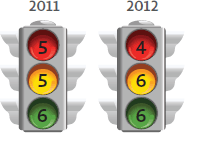 Question 7 ("What other infrastructure and surveillance needs must be met?") covers the topics of research infrastructure, data sharing, workforce development, ASD surveillance, and communication/dissemination of research findings and evidence-based practices. With 16 objectives, Question 7 has the greatest number of objectives of all seven questions in the Strategic Plan.
Question 7 ("What other infrastructure and surveillance needs must be met?") covers the topics of research infrastructure, data sharing, workforce development, ASD surveillance, and communication/dissemination of research findings and evidence-based practices. With 16 objectives, Question 7 has the greatest number of objectives of all seven questions in the Strategic Plan.
Analysis of Question 7 Portfolio 2011-2012
Objectives in Question 7 comprised 15% ($43.9 million) and 14% ($47.5 million) of the overall funding for ASD research in 2011 and 2012 respectively. While approximately 15% of the overall funding is allocated to Question 7, only 9% of the total project count in 2011 (111 projects) and 2012 (112 projects). This can partially be attributed to the high cost of large scale resources that support numerous researchers and projects such as biobanks, databases, clinics, and surveillance networks. By comparison, projects assigned to other questions are more likely to support individual research projects, and are therefore smaller in size.
In 2011, 11 of the 16 Question 7 objectives were active. Five objectives showed no progress in 2011. Table 11 provides a full list of Question 7 objectives and details of their progress. The objective that received the largest portion of funding in Question 7 (7.D) supports biobanks containing samples from individuals with ASD to be used in research (19%, $8.5 million). This was followed closely by Objective 7.N, which called for support for clinical research sites, such as the Autism Treatment Network (ATN) to collect and coordinate diagnostic, biological, medical, and treatment history data that would provide a platform for effectiveness research and clinical trials of novel autism treatments (17%, $7.4 million). Overall, 28% ($12.3 million) of the funding for projects in Question 7 was generally related to research involving infrastructure or surveillance, but not specific to an objective within that question, and thus was assigned to Core/Other (Figure 40).
In 2012, 12 of the 16 Question 7 Objectives were active. As in 2011, four objectives showed no activity in 2012, though one of those objectives (7.P) had been previously completed in 2010. The three other objectives that had no projects in 2012 and were assigned an overall red light status, including objectives to support a needs assessment toward linkage of administrative databases (7.A), replication studies (7.F), and promising practices papers about successful services delivery strategies (7.M). The Committee felt that a needs assessment toward database linkage was still a need, but the IACC was uncertain of whether the objective to develop a mechanism to support replication studies was feasible, and of whether or not promising practices papers had been replaced by other modes of dissemination. Objective 7.K, which supports investment targeted toward expansion and development of the research workforce, received the largest portion of funding in Question 7 (22%, $10.0 million). This was followed by Objective 7.I, which supplements existing Autism and Developmental Disabilities Monitoring (ADDM) Network surveillance sites to gather prevalence estimates of ASD in different regions of the country (13%, $6.0 million). Similar to 2011, 35% ($16.9 million) of the funding for projects in Question 7 in 2012 was generally related to research involving infrastructure or surveillance, but was not specific to an objective within that question, so was designated as Core/Other (Figure 40).
Objective 7.G, which calls for the development of a web-based tool that provides population estimates of ASD prevalence, had been inactive since its conception in 2010, and was reported as thus in 2011. However, in 2012, the CDC released an environmental tracking web tool which completed the requirements of this objective, changing the objective’s status to a green light in 2012. Because this web tool is used for multiple conditions and is not specific to ASD, the funding for the project was not counted in ASD research funding totals (thus in 2012, this objective had 1 project with $0).
Examples of Topics addressed by Projects in Core/Other:
- Administrative and infrastructure development
- Subject assessment and recruitment for studies
- Development of ASD research registries
- Creation of ASD research databases
Figure 40. Roughly two thirds of ASD research projects in Question 7 were coded to specific objectives; projects that did not fit within the IACC Strategic Plan objectives were coded as Core/Other. Examples of topics addressed by projects listed in Core/Other are listed above.
Question 7 Subcategory Analysis
Projects within Question 7 accounted for $43.9 million of total funding in 2011 and $47.5 million in 2012. The six subcategories in Question 7 reflect the broad array of ASD research infrastructure needs that have been identified by the IACC: Biobanks; Data tools; Research infrastructure; Research recruitment and clinical care; Research workforce development; and Surveillance and prevalence studies (Figures 41 and 42).
In 2011, Question 7 funding was relatively evenly distributed across the subcategories, with funding for general Research infrastructure representing the largest area of investment, with 24% of the funding for Question 7. This was followed by support for Biobanks that collect DNA and tissue samples from autism patients, and Data tools such as the National Database for Autism Research (NDAR) and the Autism Genetics Resource Exchange (AGRE), which both received 19% of the total funding. Research recruitment and clinical care, which help increase participation in research studies and conduct medical evaluations of participants, accounts for 15% of funding. Surveillance and prevalence studies conducted through the ADDM Network and internationally received 14% of funding. Research workforce development, which supports many conferences and training for autism researchers, received 9% of Question 7 funding.
In 2012, Research infrastructure remained the most highly-funded subcategory, accounting for 32% of Question 7 funding. Investment in Research workforce development represented 22% of funding. This was followed by Data tools (17%), and Surveillance and prevalence studies (15%), Research recruitment and clinical care (8%), and Biobanks (6%). The figures also list Federal and private funders of research that fits within the Strategic Plan Question 7 category.
2011 Question 7: Infrastructure and Surveillance – Funding by Subcategories
Total Funding: $43,855,291
Number of Projects: 111
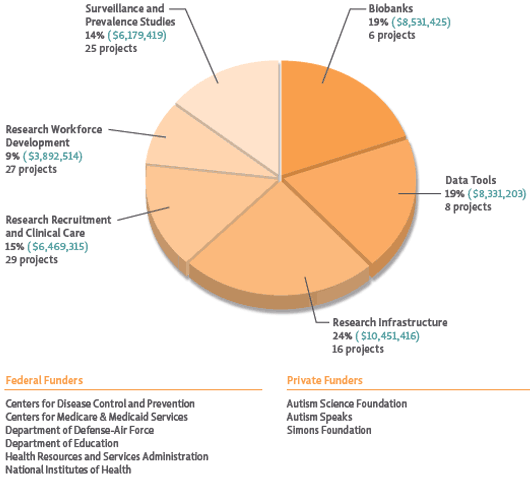
Figure 41. The six subcategories in Question 7 (Infrastructure and Surveillance) encompass a diverse set of project types, with funding distributed relatively evenly across them. In 2011, Research infrastructure received 24% of the funding, followed by support for Data tools and Biobanks, each with 19%. Research recruitment and clinical care received 15% of funding, Surveillance and prevalence studies received 14%, and Research workforce development received 9%. The figure also lists Federal and private funders of research that fits within the Strategic Plan Question 7 category.
2012 Question 7: Infrastructure and Surveillance – Funding by Subcategories
Total Funding: $47,516,197
Number of Projects: 112
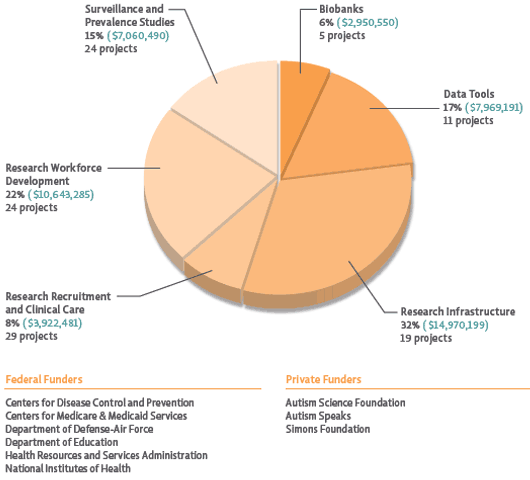
Figure 42. In 2012, Research infrastructure received 32% of the funding in Question 7 (Infrastructure and Surveillance), followed by Research workforce development with 22% of funding. Support and development of Data tools received 17% of funding, and Surveillance and prevalence studies received 15% of funding. A smaller portion of funding was allocated to Research recruitment and clinical care (8%) and Biobanks (6%). The figure also lists Federal and private funders of research that fits within the Strategic Plan Question 7 category.
Progress Made on Question 6 from 2008-2012
Table 11 describes the progress made on the 16 research objectives within Question 7 from 2009-2012 (Question 7 was not added to the Strategic Plan until the second year of the Portfolio Analysis, though some of the objectives later moved to Question 7 were originally developed earlier).8 The table also provides details regarding the status of funding for each objective, the status of research/scientific progress in each objective area, and information about remaining gaps, needs, and opportunities in each research area. Figure 43 shows the trend in Question 7 funding over time. Since 2009, when the collection of projects aligning with Question 7 began, there has been an increase in funding for research infrastructure projects from a low to a moderate level, representing significant investment that have been made over time in the core infrastructure that is needed to support ASD research. Funding levels plateaued between 2010 and 2012.
In the past five years, the majority of the 16 objectives under Question 7 have progressed. Funding for Objective 7.K, which promotes expansion of the research workforce, has also been consistently well-funded, indicative of the commitment of ASD research funders to investing in the development of the next generation of ASD researchers. A handful of objectives have not shown activity as captured by the portfolio analyses over the past five years. In some cases it is possible that the overall aim of an objective has been achieved through mechanisms not captured by the Portfolio Analyses. For example, Objective 7.G—which proposes the development of a web tool that provides population estimates of ASD prevalence—was accomplished with funding that was not captured by the Portfolio Analyses because the project was not specific to ASD.
8Since its inception in 2009, the Strategic Plan has been updated on an annual basis; however, the 2011 Strategic Plan is the most recent iteration where the objectives within the Strategic Plan were altered. Between 2009 and 2011, the updates involved significant restructuring of the Strategic Plan. This included the addition of Question 7, the addition of new objectives in other questions, as well as the renumbering and rewording of some objectives. Data included in each Portfolio Analysis report from 2008 to 2012 was categorized with respect to the most recent iteration of the Strategic Plan where the objectives had changed at the time of the analysis. Therefore, the 2008 Portfolio Analysis used the 2009 Strategic Plan, the 2009 Portfolio Analysis used the 2010 Strategic Plan, and both the 2010 Portfolio Analysis and the 2011-2012 Portfolio Analysis used the 2011 Strategic Plan. For the purpose of this five-year comparison, the objectives were aligned with the numbering used for the objectives in the 2011 Strategic Plan.
Figure 43. Question 7 ASD Research Funding from 2008-2012. Funding for Question 7 experienced an increase over the five-year span.
Question 7 Multiyear Funding Table
| IACC Strategic Plan Objectives | Funding | |||||
|---|---|---|---|---|---|---|
| Year | 2008 | 2009 | 2010 | 2011 | 2012 | Total |
IACC Strategic Plan ObjectivesConduct a needs assessment to determine how to merge or link administrative and/or surveillance databases that allow for tracking the involvement of people living with ASD in health care, education, and social services by 2009. IACC Recommended Budget: $520,000 over 1 year |
Funding 20086.4 |
Funding 20097.A |
Funding 20107.A |
Funding 20117.A |
Funding 20127.A |
Funding Total$0 |
6.S.A. Funding: There has been no specific funding for projects addressing this objective. Progress: The Planning Group is not aware of any efforts (projects or funding) that have been made to address this objective since it was created. Remaining Gaps, Needs, and Opportunities: A needs assessment remains necessary due to issues surrounding patient privacy in linked databases and also to determine how tracking the involvement of people with ASD in health care, education, and social services is possible with existing tools and resources. It remains to be decided whether this should be a government-led effort or a public/private partnership. Such resources could be utilized by both the research and services provision communities. |
||||||
| IACC Strategic Plan Objectives | Funding | |||||
| Year | 2008 | 2009 | 2010 | 2011 | 2012 | Total |
IACC Strategic Plan ObjectivesConduct an annual “State of the States” assessment of existing State programs and supports for people and families living with ASD by 2011. IACC Recommended Budget: $300,000 each year (revised in 2010) |
Funding 20085.1 |
Funding 20097.B |
Funding 20107.B |
Funding 20117.B |
Funding 20127.B |
Funding Total$604,013 |
7.B. Funding: The recommended budget was partially met. Progress: Centers for Medicare & Medicaid Services (CMS) conducted a “State of the States” project and released a report summarizing the results of the study in 2014. The book Autism Services Across America by Dr. Peter Doehring also reviews existing programs and services across the states. Remaining Gaps, Needs, and Opportunities: The initial State of the States study, overseen by CMS, was completed and published in 2014, but the objective calls for an annual study. Since the first study required multiple years to complete and since it is not clear if services will change enough yearly to warrant an annual study, this objective should be revisited with CMS to understand whether an annual study is the best approach. |
||||||
| IACC Strategic Plan Objectives | Funding | |||||
| Year | 2008 | 2009 | 2010 | 2011 | 2012 | Total |
IACC Strategic Plan ObjectivesDevelop and have available to the research community means by which to merge or link databases that allow for tracking the involvement of people in ASD research by 2010. IACC Recommended Budget: $1,300,000 over 2 years |
Funding 20086.1 |
Funding 20097.C |
Funding 20107.C |
Funding 20117.C |
Funding 20127.C |
Funding Total$13,590,660 |
7.C. Funding: The recommended budget was met. Significantly more than the recommended minimum budget was allocated to projects specific to this objective. Progress: IAN and Group Health Cooperative Autism Registry are two examples of projects that are responsive to this objective. This objective should be considered to be met, with funding exceeding the recommended budget and a large number of diverse projects addressing this issue. NDAR, IAN and AGRE are all publicly available databases. Remaining Gaps, Needs, and Opportunities: To advance this objective we need to encourage patients and families to join the registry. Compared to registry numbers for cystic fibrosis (100%), autism is behind at ˜4% of patients enrolled in a registry. A table of the numbers of registrants by year would be an informative figure. We need more organized systems to improve participation. |
||||||
| IACC Strategic Plan Objectives | Funding | |||||
| Year | 2008 | 2009 | 2010 | 2011 | 2012 | Total |
IACC Strategic Plan ObjectivesEstablish and maintain an international network of biobanks for the collection of brain tissue, fibroblasts for pluripotent stem cells, and other tissue or biological material, by acquisition sites that use standardized protocols for phenotyping, collection, and regulated distribution of limited samples by 2011.
IACC Recommended Budget: $82,700,000 over 5 years (revised in 2011) |
Funding 20082.1 & 2.6 |
Funding 20097.D |
Funding 20107.D |
Funding 20117.D |
Funding 20127.D |
Funding Total$24,754,287 |
7.D. Funding: The recommended budget was partially met. In terms of autism-specific projects, $24.7 million has been spent to date. Including non-autism-specific projects called for in the objective (i.e., the brain atlas), $59.6 million has been spent to date. Progress: NIH launched a new multi-disorder Neurobiobank initiative in 2013. The $5 million effort encompasses autism and other brain disorders, and is not included in the 2008-2012 projects examined by the committee for this update because it began in 2013. A private effort, the Autism BrainNet, is also underway, with several collection/storage/distribution sites governed by a scientific board which distributes samples based on scientific merit of proposed projects to use the tissue. Though these two efforts represent progress, more work is needed to increase the amount of tissues available and to ensure good stewardship of these resources. The BrainSpan Atlas, supported by the Allen Brain Institute and a consortium of government and private funders, was completed and launched in 2011 and provides a powerful new resource for data on gene expression in the brain during development, but the project is not reflected in the 2008-2012 funding figures because it is not autism specific. In 2009, NIH supported the atlas with $18.4 million dollars and in 2010, NIH provided $16.5 million. The NIMH Repository and Genomics Resource is another resource that has continued to grow to meet the needs of researchers in many fields, including ASD research. Current sample numbers in the repository are: 28,300 DNA samples, with 15,700 samples that have been processed and prepared for distribution and 6,300 cases of autism represented. There are 21 fibroblast lines and 25 induced pluripotent stem cell lines. Remaining Gaps, Needs, and Opportunities: While progress has been made in establishing, maintaining and expanding tissue resources for research, this is still an area of enormous need. Currently there may be fewer brain samples available for study than there were at the inception of the Strategic Plan due to the failure of a freezer at a major brain bank in 2012, which resulted in the loss of a large number of ASD brain specimens. There is also still a need for tissue and brains from neurotypical controls. Compared to other disorders, the number of tissue samples available for ASD research is quite low. |
||||||
| IACC Strategic Plan Objectives | Funding | |||||
| Year | 2008 | 2009 | 2010 | 2011 | 2012 | Total |
IACC Strategic Plan ObjectivesBegin development of a web-based toolbox to assist researchers in effectively and responsibly disseminating their findings to the community, including people with ASD, their families, and health practitioners by 2011. IACC Recommended Budget: $400,000 over 2 years |
Funding 2008N/A |
Funding 20097.E |
Funding 20107.E |
Funding 20117.E |
Funding 20127.E |
Funding Total$1,254,150 |
7.E. Funding: The recommended budget was met. Significantly more than the recommended minimum budget was allocated to projects specific to this objective. Progress: The goal of objective has been achieved in terms of efforts to help researchers more effectively disseminate their findings to the community online and in lay-friendly formats, but not through a web-based toolbox. For example, several agencies, organizations and groups (CDC, NIH, Simons Foundation, Autism Speaks, ASF, IAN) publish lay-friendly summaries of recent scientific findings online, as well as lay-friendly versions of their reports. In addition, the “Data from Papers” feature in NDAR connects readers from the Pubmed citation of a study to the actual data deposited in the database. Remaining Gaps, Needs, and Opportunities: Though agencies and organizations are making active efforts to assist researchers with disseminating findings to the community via the web, access to information about research findings remains limited for those communities that are resource-poor and do not have internet access. In addition, the lack of open access to most peer-reviewed journals limits the public’s ability to access fully detailed information about new findings. |
||||||
| IACC Strategic Plan Objectives | Funding | |||||
| Year | 2008 | 2009 | 2010 | 2011 | 2012 | Total |
IACC Strategic Plan ObjectivesCreate funding mechanisms that encourage rapid replication studies of novel or critical findings by 2011. No recommended budget assigned by the IACC |
Funding 2008N/A |
Funding 20097.F |
Funding 20107.F |
Funding 20117.F |
Funding 20127.F |
Funding Total$0 |
7.F. Funding: TThere has been no specific funding for this objective. Progress: There are no projects categorized to this objective. The Planning Group discussed the issue that creation of funding mechanisms is not likely to be achieved through grant funding, and therefore would not be reflected in the grant portfolio. Remaining Gaps, Needs, and Opportunities: The Committee still feels that this objective is relevant and that it is not too early to begin replication studies. In the databases there are 70,000 subjects, 7,000 exomes and 2,500 MRIs that can be used for replication analysis. The intent of the objective was to quickly replicate findings related to potential treatments, but to date, no special fast-track funding mechanisms have been established to support this. |
||||||
| IACC Strategic Plan Objectives | Funding | |||||
| Year | 2008 | 2009 | 2010 | 2011 | 2012 | Total |
IACC Strategic Plan ObjectivesDevelop a web-based tool that provides population estimates of ASD prevalence for States based on the most recent prevalence range and average identified by the ADDM Network by 2012. IACC Recommended Budget: $200,000 over 2 years |
Funding 2008N/A |
Funding 20097.G |
Funding 20107.G |
Funding 20117.G |
Funding 20127.G |
Funding Total$0 |
7.G. Funding: Autism tracking data is captured in CDC’s environmental tracking tool, which became available to the public in 2012, and is not reflected in the autism grant portfolio figure because it is a general tool that encompasses multiple disorders and conditions. Progress: The intent of this objective has been accomplished through the CDC project and can be considered completed. Remaining Gaps, Needs, and Opportunities: No new needs or opportunities in this area were identified. |
||||||
| IACC Strategic Plan Objectives | Funding | |||||
| Year | 2008 | 2009 | 2010 | 2011 | 2012 | Total |
IACC Strategic Plan ObjectivesCreate mechanisms to specifically support the contribution of data from 90% of newly initiated projects to the National Database for Autism Research (NDAR), and link NDAR with other existing data resources by 2012. IACC Recommended Budget: $6,800,000 over 2 years |
Funding 2008N/A |
Funding 20097.H |
Funding 20107.H |
Funding 20117.H |
Funding 20127.H |
Funding Total$9,583,653 |
7.H. Funding: The recommended budget for this objective was met. Progress: The objective to create mechanisms to support the contribution of data from newly initiated projects to NDAR has been met, and NDAR has linked with several other existing data sources such as the ATP, AGRE and IAN. In 2012, 81% of NIH-funded extramural studies were contributing data to NDAR. All NIH grants have terms that require linking of data to NDAR. Remaining Gaps, Needs, and Opportunities: Infrastructure will need continued development to enable greater availability of standardized data and analytical tools for cloud computing. IAN data collection could be expanded to include locations of residence to enable geographic data collection on environmental exposures. |
||||||
| IACC Strategic Plan Objectives | Funding | |||||
| Year | 2008 | 2009 | 2010 | 2011 | 2012 | Total |
IACC Strategic Plan ObjectivesSupplement existing ADDM Network sites to use population-based surveillance data to conduct at least five hypothesis-driven analyses evaluating factors that may contribute to changes in ASD prevalence by 2012. IACC Recommended Budget: $660,000 over 2 years |
Funding 2008N/A |
Funding 20097.I |
Funding 20107.I |
Funding 20117.I |
Funding 20127.I |
Funding Total$9,583,653 |
7.I. Funding: The recommended budget was met. Significantly more than the recommended minimum budget was allocated to projects specific to this objective. (Note that the funding amount for this objective reflects the full funding of the ADDM sites and not just the supplements.) Progress: The research goals in the objective have been achieved. Initially, supplements were needed to support these analyses, but now the ADDM sites are well established and are conducting some analyses using funds from the ADDM grants themselves, while outside supplements are supporting other additional analyses. Remaining Gaps, Needs, and Opportunities: Supplements remain an opportunity to capitalize on this infrastructure. |
||||||
| IACC Strategic Plan Objectives | Funding | |||||
| Year | 2008 | 2009 | 2010 | 2011 | 2012 | Total |
IACC Strategic Plan ObjectivesDevelop the personnel and technical infrastructure to assist States, territories, and other countries that request assistance describing and investigating potential changes in the prevalence of ASD and other developmental disabilities by 2013. IACC Recommended Budget: $1,650,000 over 3 years |
Funding 2008N/A |
Funding 20097.J |
Funding 20107.J |
Funding 20117.J |
Funding 20127.J |
Funding Total$1,521,508 |
7.J. Funding: The recommended budget was met. In addition, the Autism Speaks Global Health Initiative projects address this objective, though they have been coded to their specific scientific areas and are not represented in this funding amount. Also, the CDC provides personnel and help to States, territories and countries as requested, but the budget for that assistance is not reflected in the portfolio analysis figures because this work is not done through grants. Progress: Progress has been made in addressing this need, but not all responsive projects were reflected in the funding amount because some of them were conducted through sources not captured in the portfolio analysis (non-autism specific funding sources) or the projects were assigned according to their scientific topics rather than to this objective. In addition to providing supplemental funding for ADDM site surveillance, Autism Speaks funds projects on surveillance conducted by sites outside of the ADDM network, such as the Kwa-Zulu-Natal Autism Study in South Africa. Remaining Gaps, Needs, and Opportunities: While progress has been achieved, ongoing efforts are needed in this area. |
||||||
| IACC Strategic Plan Objectives | Funding | |||||
| Year | 2008 | 2009 | 2010 | 2011 | 2012 | Total |
IACC Strategic Plan ObjectivesEncourage programs and funding mechanisms that expand the research workforce, enhance interdisciplinary research training, and recruit early-career scientists into the ASD field by 2013. IACC Recommended Budget: $5,000,000 over 3 years |
Funding 2008N/A |
Funding 20097.K |
Funding 20107.K |
Funding 20117.K |
Funding 20127.K |
Funding Total$24,702,276 |
7.K. Funding: The recommended budget was met. Significantly more than the recommended minimum budget was allocated to projects specific to this objective. Many of the fellowship grants are coded according to the specific topic of the research conducted and thus are not represented in this funding figure. Progress: In 2008, NIH supported 46 autism related training/fellowship grants ($5.1 million), and in 2012 NIH supported 78 such grants ($7.7 million). Remaining Gaps, Needs, and Opportunities: This objective should continue to be encouraged with a possible future emphasis on services-based research. |
||||||
| IACC Strategic Plan Objectives | Funding | |||||
| Year | 2008 | 2009 | 2010 | 2011 | 2012 | Total |
IACC Strategic Plan ObjectivesExpand the number of ADDM sites in order to conduct ASD surveillance in children and adults; conduct complementary direct screening to inform completeness of ongoing surveillance; and expand efforts to include autism subtypes by 2015. IACC Recommended Budget: $16,200,000 over 5 years |
Funding 2008N/A |
Funding 20097.L |
Funding 20107.L |
Funding 20117.L |
Funding 20127.L |
Funding Total$3,681,460 |
7.L. Funding: The recommended budget was partially met, but it is noted that the full funding of the ADDM sites is reflected in Objective 7.I. and thus there may be underrepresentation of funding in this category. Progress: Supplements have been provided to six ADDM sites by CDC to collect data from a younger cohort (4-year-olds) in addition to the 8 year olds currently studied; two other ADDM sites have received supplements from CDC to conduct surveillance studies among 15 to 18 year olds. Despite these expansions, further work is needed to better understand prevalence in both younger and older populations. A current project at UNC is reassembling those who participated in TEACCH to conduct a study of long-term outcomes. Also, Paul Shattuck has published studies on young adults with disabilities seeking services that have revealed a significant drop in services use and access post-high school, along with an increased likelihood to remain living with a parent or guardian. In addition, the Utah cohort (mentioned in Question 6) has been used for studies related to adults with autism, with a recent paper identifying health risks and causes of mortality. Remaining Gaps, Needs, and Opportunities: While subtypes were included as part of this objective, with the changes in the DSM to eliminate subtypes, this portion of the objective may no longer be relevant. In the future it may be more useful to collect data on characteristics of children and adults with ASD who participate in studies. |
||||||
| IACC Strategic Plan Objectives | Funding | |||||
| Year | 2008 | 2009 | 2010 | 2011 | 2012 | Total |
IACC Strategic Plan ObjectivesSupport 10 “Promising Practices” papers that describe innovative and successful services and supports being implemented in communities that benefit the full spectrum of people with ASD, which can be replicated in other communities, by 2015. IACC Recommended Budget: $75,000 over 5 years |
Funding 2008N/A |
Funding 20097.M |
Funding 20107.M |
Funding 20117.M |
Funding 20127.M |
Funding Total$0 |
7.M. Funding: There has been no specific funding for this objective. Progress: CMS is no longer supporting the program that produced the earlier promising practices papers; it is possible that other methods of disseminating best practices information are now being used. Remaining Gaps, Needs, and Opportunities: Best practices information dissemination is still a high priority, but there may be other means by which this is being done. The focus should be on achieving dissemination rather than on the particular method used. Perhaps this objective should be revisited and replaced with a version that reflects current needs and practices or combined with another objective as appropriate in the future. |
||||||
| IACC Strategic Plan Objectives | Funding | |||||
| Year | 2008 | 2009 | 2010 | 2011 | 2012 | Total |
IACC Strategic Plan ObjectivesEnhance networks of clinical research sites offering clinical care in real-world settings that can collect and coordinate standardized and comprehensive diagnostic, biological (e.g., DNA, plasma, fibroblasts, urine), medical, and treatment history data that would provide a platform for conducting comparative effectiveness research and clinical trials of novel autism treatments by 2012. IACC Recommended Budget: $1,850,000 over 1 year |
Funding 2008N/A |
Funding 2009N/A |
Funding 20107.N |
Funding 20117.N |
Funding 20127.N |
Funding Total$19,353,505 |
7.N. Funding: The recommended budget was met. Significantly more than the recommended minimum budget was allocated to projects specific to this objective. Progress: Autism Speaks’ ATN is a care network that also has research capabilities. The ATN has a collection of biological samples collected from patients who have sought care at the ATN. However, these samples are not targeted toward research use because the samples are not broadly shared like those from other repositories and the samples were not collected systematically. As the ATN has progressed in its work, it has shifted away from the goal of creating a repository to a new focus on developing clinical guidelines, especially in the area of co-occurring conditions. Several guidelines have been published. Another network, the IAN, has piloted a new rapid method of conducting “virtual” clinical trials of low-risk or “safe” treatments. For example, IAN conducted a trial on omega 3 fatty acids – a commonly used dietary supplement – across 40 states in 10 weeks, demonstrating the value of using interactive research networks for these types of trials. Remaining Gaps, Needs, and Opportunities: Clinical and patient social networks represent new ways to conduct research (“practice to research”), as well as a path for evaluating interventions that do not require extensive safety testing (e.g., alternate diets or technological interventions) quickly using large social networks. |
||||||
| IACC Strategic Plan Objectives | Funding | |||||
| Year | 2008 | 2009 | 2010 | 2011 | 2012 | Total |
IACC Strategic Plan ObjectivesCreate an information resource for ASD researchers (e.g., PhenX Project ) to share information to facilitate data sharing and standardization of methods across projects by 2013.
IACC Recommended Budget: $2,000,000 over 2 years |
Funding 2008N/A |
Funding 2009N/A |
Funding 20107.O |
Funding 20117.O |
Funding 20127.O |
Funding Total$2,404,279 |
7.O. Funding: The recommended budget for this objective was met. Progress: A small number of projects specific to this objective were funded. In addition, there are other projects that are responsive to the goals of this objective, but are coded elsewhere. For example, NDAR has developed a data dictionary that is now widely used across the research community to standardize data terminology so that data can be uniformly shared among researchers. Funding for this project is not reflected in the total for this objective because NDAR is coded elsewhere. NDAR also has a human subject common identifier that is now broadly used by the community. Remaining Gaps, Needs, and Opportunities: Funding is necessary to develop standardized methods and protocols. This is a long term project and will need to be approached carefully. |
||||||
| IACC Strategic Plan Objectives | Funding | |||||
| Year | 2008 | 2009 | 2010 | 2011 | 2012 | Total |
IACC Strategic Plan ObjectivesProvide resources to centers or facilities that develop promising vertebrate and invertebrate model systems, and make these models more easily available or expand the utility of current model systems, and support new approaches to develop high-throughput screening technologies to evaluate the validity of model systems by 2013. IACC Recommended Budget: $1,100,000 over 2 years |
Funding 2008N/A |
Funding 2009N/A |
Funding 20107.P |
Funding 20117.P |
Funding 20127.P |
Funding Total$1,588,780 |
7.P. Funding: The recommended budget for this objective was met. Progress: The project in the Portfolio Analysis that addresses this objective is a NIMH intramural project to produce transgenic mouse models of mental and neurodevelopmental disorders, including ASD. In addition, when mouse models are made under grants and projects coded elsewhere in the portfolio, they are shared via Jackson Laboratories, and that funding is not reflected here. Remaining Gaps, Needs, and Opportunities: Emphasis on providing means to encourage development and sharing of animal models, and development of assays that can be used in animal models is still required to advance basic and translational ASD research. |
||||||
| IACC Strategic Plan Objectives | Funding | |||||
| Year | 2008 | 2009 | 2010 | 2011 | 2012 | Total |
IACC Strategic Plan ObjectivesNot specific to any objective (Core/Other Activities) |
Funding 2008N/A |
Funding 20097. Core/Other Activities |
Funding 20107. Core/Other Activities |
Funding 20117. Core/Other Activities |
Funding 20127. Core/Other Activities |
Funding Total$43,431,065 |
IACC Strategic Plan Objectives†Reported funding for Question 7* |
Funding 2008N/A |
Funding 2009$15,809,755 |
Funding 2010$50,847,065 |
Funding 2011$43,855,291 |
Funding 2012$47,516,197 |
Funding Total$26,604,411 |
IACC Strategic Plan Objectives†Adjusted funding for Question 7† |
Funding 2008$12,098,057 |
Funding 2009$15,809,755 |
Funding 2010$50,847,065 |
Funding 2011$43,855,291 |
Funding 2012$47,516,197 |
Funding Total$170,126,365 |
Question 7 Multiyear Funding Table, see appendix for a color-coding key and further details.
*The “Reported funding” totals reflect the funding and projects originally coded to this Question of the Strategic Plan, as reported in the Portfolio Analysis Report corresponding to the year indicated at the top of the column. When reading each column of the table vertically, please note that the projects and funding associated with each objective for 2008 may not add up to the reported funding total at the bottom of the column; this is due to adjustments made to account for revisions in the Strategic Plan, which caused the shifting of some objectives to other Questions under the Plan. The projects and funding associated with these reclassified objectives are now reflected under the Question in which they appear in the 2011 Strategic Plan.
†The “Adjusted funding” total reflects funding for projects aligned to objectives in the 2011 IACC Strategic Plan (the most recent version in which objectives were revised) and incorporates funding for projects that may have been coded differently under previous versions of the Plan.
Table 11. Question 7 Multiyear Funding Table.


